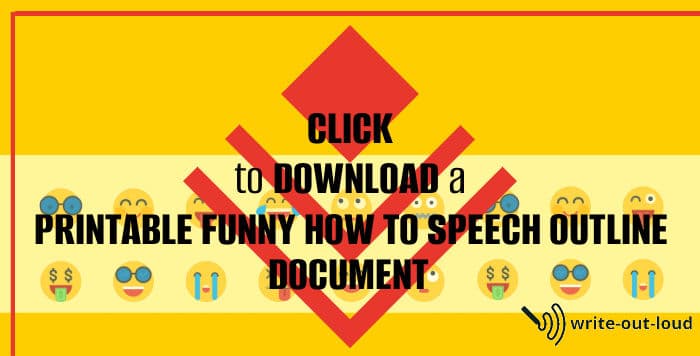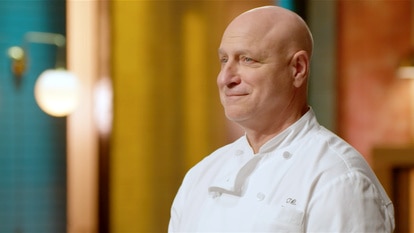- Get In Touch


How to be funny in a speech (when you’re not that funny in real life).
by Kolarele Sonaike

According to a Hertfordshire University study , this is the funniest joke in the world.
“Two hunters are out in the woods when one of them collapses. He doesn’t seem to be breathing and his eyes are glazed. The other guy whips out his phone and calls the emergency services. He gasps, “My friend is dead! What can I do?” The operator says, “Calm down. I can help. First, let’s make sure he’s dead.” There is a silence; then a gun shot is heard. Back on the phone, the guy says, “OK, now what?”
Hmm. OK, once you’ve finished laughing, picked yourself up from the floor and wiped away those tears of laughter, lets examine the subject of humour.
There is no lonelier place on the planet, than on stage after a bad joke.
It is possibly the single most painful experience for any public speaker.
Comedians know this, which is why they work so hard at their craft. Comedians aren’t funny in real life. Like any other profession, funny is what they do, not what they are. Comedians work and struggle just like the rest of us to be good at their jobs. Ellen, Jerry Seinfeld, Chris Rock – all the greatest comics write, rewrite and rehearse their routines with incredible care, diligence and attention to detail. They try out material for months, sometimes years in advance, on audiences – sifting out the stuff that doesn’t work, and doubling down on the lines that do.

(Getty Images)
So why, oh why, do so many of us as public speakers always assume that we can just shoehorn a couple of lame one liners (found on the internet) into a barely rehearsed speech, and get big laughs from our audience? This is guaranteed to fail every time, reminding us of the words of writer, Quentin Crisp:
if at first you don’t succeed, failure may be your style – Quentin Crisp
( If you’re pushed for time, you can download the Free Checklist of this article: Dos & Donts of giving funny speeches )
Being funny in a speech is hard to pull off. But like most hard things, with a little study, much practice, and a healthy dose of chutzpah, anyone can do it. So lets examine the anatomy of a joke in the next section helpfully called “Anatomy of a Joke”
Anatomy of a Joke
All comedy, whether a one liner, long anecdote, or even an entire movie, is basically comprised of two parts: The Set Up and the Pay Off (also known as The Punchline).

With the Set Up, you are setting the scene by giving the audience all the information they need to know so that they will be amused by the Pay Off.
1) Set Up: Knock Knock. Who’s there? Dozen. Dozen who?
2) Set Up: In the movie “Some like it hot” eccentric millionaire, Osgood Fielding III, spends the whole movie chasing Tony Curtis’ character, Jerry (dressed in drag pretending to be a woman).
3) Set Up: Dr Evil (Austin Powers) has been cryogenically frozen for 30 years, so when he meets his evil colleagues, he lays out his plan to extort the world for a huge sum of money.
4) Set Up (in the world’s funniest joke) The hunter dies in the woods and his panicking friend calls the emergency services.
The mistake that most public speakers make that leads to them giving unfunny speeches, is to concentrate all their effort almost entirely on finding that Pay Off, asking themselves ‘what’s the funny line that I can say here?’ Whereas the key to humour is to focus on creating a compelling Set Up so that the right Pay Off just reveals itself.

To create a great Set Up:
1) Take a subject (ideally one with which you are very familiar)
2) Examine it from all angles looking for the surprising contradictions and unexpected anomalies within the subject.
3) Work out how you can exaggerate those contradictions and anomalies almost to the point of a humorous absurdity. Can you connect one seemingly unconnected topic with another? Can you take a particular approach that will highlight these funny contradictions?
The humour lies in those unexpected findings and exaggeration that are nevertheless real. It’s why you find yourself muttering ‘that’s so true’ through your tears of laughter when listening to a hilarious comedian nail her routine. It’s why a Best Man’s speech works best when it skates on the edge of decency by revealing just enough of the groom’s true nature to the audience (and the Bride).
When you work hard on your Set Up, the Pay Off comes pretty easily because the punchline that ties it altogether seems to reveal itself.
1) Pay Off: Doz-anybody want to let me in?
2) Pay Off: (Some like it hot) Tony Curtis finally comes clean and declares to millionaire Osgood,”I’m a man!” To which Osgood simply replies “Well, nobody’s perfect”
3) Pay Off: (Austin Powers) Dr Evil demands…. 1 Million Dollars
4) Pay Off: (The funniest joke in the world) The friend shoots his collapsed hunter friend.

A very effective method of creating a compelling Set Up is to use a hook or theme that drives the narrative forward.
A great example is the ‘Shit’ sketch by Finnish comedian, Ismo Leikola . In this hilarious skit, he talks about how he always though there was just one definition or meaning of the word ‘shit’. But when he went to the US, he realised there were many more meanings like ‘you ain’t shit’, ‘I don’t give a shit’, ‘leave my shit alone’. Because he had found a great hook for the narrative, finding the humour was quite easy.
So, when you’re giving a speech about a serious subject like ‘How the Financial Markets work’, but you want to introduce a little humour to ease the way, consider what are the eccentricities of the financial markets? What parts make little sense if you stand back and look at it? What would your 8 year old son or your 80 year old grandmother make of the way traders?
Or giving a presentation at a small business forum, what eccentricities do entrepreneurs have? What challenges do they all face that you can highlight in a funny way? What mistake does nearly every small business make, which no one admits do, but every one knows?
This is where you’ll find your humour – in the careful analysis of the contradictions within your subject . Once you tap into that zone, a whole new world will open up and the Pay Offs will almost trip off your tongue.
Finally, a few dos and donts to send you on your way

maria bamford (Getty Images)
1) Don’t tell them you are going to be funny.
Anytime I receive an an email with the subject line: “This is funny”, I delete it. It never is. If you’re going to be funny, then be funny. Don’t announce it.
2) Do have a purpose
As one of the greatest and funniest public speakers, the late Sir Peter Ustinov reminds us
Comedy is simply a funny way of being serious – Sir Peter Ustinov
Don’t make jokes just for the sake of making joke. Stay focused on the reason you are giving your speech, and use humour to help achieve that objective.
3) Don’t copy. Adapt.
The best jokes are original. Your own material, born of your own experience will always be superior to something copied off jokes.com.
But originality can be hard. So, if you do have to use someone else’s material, approach it like Amy Winehouse covering the song ‘Valerie’ originally by the Zutons (bet you hadnt even heard of the Zuton’s version), and not like a teenage X Factor contestant doing yet another cover of Whitney Houston’s ‘I will always love you’ (which itself was a cover of Dolly Parton’s original song).
Put your own spin on it. Make it your own and it will feel fresh.
4) Do tailor your jokes to your audience
What works for a university fraternity will probably not work for an accountant’s convention. Lawyers love a good naughty joke (it makes us feel dangerous), but you should probably avoid sexist jokes if you’re presenting to the Women’s Institute.
5) Don’t take yourself too seriously
If you can make jokes at your own expense, you’ve got a far better chance of making your audience laugh, than if you are joking about someone else.
Never be afraid to laugh at yourself, after all, you could be missing out on the joke of the century – And Barry Humphries
And when it comes to your delivery, you want to use your voice to help paint a picture of your ideas in the minds of your audience. Treat it as a song or melody you are singing to your audience. The things you want to think about are:
- timing – uses pauses and speed variation to build interest
- use your body to amplify and reflect your words
- give your voice dynamism i.e. intonation, pitch, volume
- commit (don’t do things half hearted)

Go forth, and be funny!
(Grab the full Checklist of 12 Dos & Donts for giving a funny speech )
Kolarele Sonaike
p.s. Grab your slot for a 1 hour communication skills coaching call with me. It’s free and pretty transformative. Click here to book your slot.
“ The session with Kola had a huge impact. He helped me tap into the passion that is central to my work and message. At an emotional level this showed me how I could start working with a different sense of authenticity, which would be founded upon a new level of confidence and commitment. The session really ‘gave the green light’ for me to tell my story in my approach so I could in turn create genuine impact the people I work with.” – Richard, Performance Coach
“The strategy session with Kolarele was great. In only one hour he was able to provide me with tools to work with to overcome some of my fears and improve my communication skills. I feel I have already made progress. I can only imagine what transformation will look like once we continue working together.” – Belinda, Co Founder
“Understanding how my presentation skills could be improved required me to understand my own long held inhibitions. Identifying this was both scary and enlightening, but seriously made me feel that I could give, not only a great presentation, but achieve my bigger goals. Thank you” – Yves, Marketing & PR (Embassy Liaison) Manager
Pin It on Pinterest
- PRO Courses Guides New Tech Help Pro Expert Videos About wikiHow Pro Upgrade Sign In
- EDIT Edit this Article
- EXPLORE Tech Help Pro About Us Random Article Quizzes Request a New Article Community Dashboard This Or That Game Popular Categories Arts and Entertainment Artwork Books Movies Computers and Electronics Computers Phone Skills Technology Hacks Health Men's Health Mental Health Women's Health Relationships Dating Love Relationship Issues Hobbies and Crafts Crafts Drawing Games Education & Communication Communication Skills Personal Development Studying Personal Care and Style Fashion Hair Care Personal Hygiene Youth Personal Care School Stuff Dating All Categories Arts and Entertainment Finance and Business Home and Garden Relationship Quizzes Cars & Other Vehicles Food and Entertaining Personal Care and Style Sports and Fitness Computers and Electronics Health Pets and Animals Travel Education & Communication Hobbies and Crafts Philosophy and Religion Work World Family Life Holidays and Traditions Relationships Youth
- Browse Articles
- Learn Something New
- Quizzes Hot
- This Or That Game New
- Train Your Brain
- Explore More
- Support wikiHow
- About wikiHow
- Log in / Sign up
- Education and Communications
- Communication Skills
- Public Speaking
- Speechwriting
How to Write a Funny Speech
Last Updated: March 29, 2024 Fact Checked
This article was co-authored by Patrick Muñoz . Patrick is an internationally recognized Voice & Speech Coach, focusing on public speaking, vocal power, accent and dialects, accent reduction, voiceover, acting and speech therapy. He has worked with clients such as Penelope Cruz, Eva Longoria, and Roselyn Sanchez. He was voted LA's Favorite Voice and Dialect Coach by BACKSTAGE, is the voice and speech coach for Disney and Turner Classic Movies, and is a member of Voice and Speech Trainers Association. There are 8 references cited in this article, which can be found at the bottom of the page. This article has been fact-checked, ensuring the accuracy of any cited facts and confirming the authority of its sources. This article has been viewed 169,751 times.
Writing a speech is already a challenge, so why bother adding humor? Successful humor will relax the audience, making them more attentive and receptive. It can break down perceived barriers between you and the audience, fostering a sense of camaraderie with the audience. Read on to learn how to use humor to your advantage when giving a speech. [1] X Research source
Choosing Your Topic

- Think about -- and then make -- a list of things you know a lot about or enjoy talking about. Single out the topics you’re knowledgeable about but also know you can be funny about. This might rule out topics that are hard to joke about, like poverty, domestic violence, etc.
- Use this list (in combination with the next step) to select a potential topic.

- What’s the general age of your audience?
- What do your audience members have in common?
- What kind of speech are they expecting to hear?
- What kind of humor are they likely to appreciate?

- If you’re writing a speech whose primary goal is to convey information or ideas, you’ll want to integrate humor while focussing on the ideas you want to convey. So draft the informative parts of your speech first, then integrate jokes and humor.
- If you’re writing a speech whose primary goal is humor -- perhaps a satire or parody -- then you’ll want the humor center stage from the beginning. Choose a topic that lends itself to your sense of humor as well as to what the audience is likely to find amusing.
Writing Your Speech

- Remember to choose a specific topic -- if your main idea/topic is too broad, you won’t do it justice in a relatively short speech. Choose something that you can describe in reasonable depth in the time allotted.
- For example, if you’re writing a humorously informative speech about early American cinema, your main idea might be, “the advent of sound in film hurt rather than helped the medium by detracting from its visual potential”. This is specific enough not to be overwhelming while still leaving you room to develop substantial supporting points.
- If, on the other hand, you’re writing a satirical speech, say, about reality television, your main idea might be, “nothing has contributed more to the cultural and intellectual richness of American society than reality television”.

Mine your own unique experiences for inspiration. "It's always good to take something that's happened in your life and make something of it comedically."

- Write down your main idea.
- Below it, write out everything that comes to mind when you think about that idea. Use whatever visual or textual brainstorming method you prefer (eg, clustering, listing, freewriting, etc.).
- Eliminate anything that’s too far away from the topic, that you don’t feel comfortable discussing, or that would require too much time and depth to cover.

- I. Introduction (where you state your main topic and the points you’ll make)
- II. Main point one
- III. Main point two
- IV. Main point three
- V. Conclusion (in which you sum up the main points, re-state your main idea, and issue a call to action from the audience, if appropriate)

- Effective hooks include humorous personal anecdotes, surprising or entertaining examples, or direct questions to the audience that invite their participation and give them a chance to laugh at themselves. [10] X Trustworthy Source University of North Carolina Writing Center UNC's on-campus and online instructional service that provides assistance to students, faculty, and others during the writing process Go to source
- For example, if you’re writing a speech about studying abroad, you might start by asking if anyone has ever wished they had an accent or intentionally faked one. You can then suggest they do it right and live somewhere they’ll actually have a legitimate accent.

- Err on the side of clarity over style, subtlety or artistry. Unlike a written piece, a speech is as much about delivery as it is about content, and the audience will be less attuned to the intricacies of sentence construction and more attuned to your overall message and the expressions as you give it.
- Avoid overly long and complicated sentences. Long and difficult sentences will be hard to follow. Simplify your point and/or break complicated sentences into smaller, more easily digested ideas.

- For example, a word like “incendiary” is both more vivid, specific, and aurally interesting than a word such as “controversial”. “Incendiary” communicates the idea of something explosively provocative, while “controversial” is a more general term for something that generates disagreement.
Incorporating Humor

- Consider generational differences with humor -- use references and jokes that address topical issues for that age group. For example, if you’re writing a speech about volunteering to an audience of high school students, relate the information in your speech to specific things and events relevant to teenagers. You might make a joke about volunteering versus staying home and trying to be Jimi Hendrix on Guitar Hero. Or you might pick a guitarist more recent than Jimi!
- Know what the audience members have in common. Use it when writing jokes oriented around those shared elements, which are more likely to hold the audience’s attention. Doing so is invariably a crowd-pleaser. For example, if you’re addressing teachers, you might make a humorous reference to students’ most bizarre homework excuses.
- Situational and observational humor that’s tailored to its audience is often particularly effective.

- Watch your favorite funny movie, television show, or comedian.
- Read works by your favorite humorous writers.
- Don’t hesitate to take cues from their delivery -- learn from what they do to make a joke successful. (But don’t plagiarize!)
- Pay attention when you make people around you laugh. Note the things you do or say that make people laugh and how you do it.
- If, for example, your friends can’t stop laughing when you humorously re-enact stressful situations or conversations, try to incorporate similar elements into your speech.

- Targeting particular people or groups is not only inconsiderate, it can alienate members of your audience.
- Avoid jokes that are made at the expense of one side or another in a contentious issue, like jokes about one side of a political or religious debate.
- Don’t make jokes about experiences you don’t understand. A good general rule is to write what you know. So if you, for example, have a learning disability, you might make a joke about the difficulties of dealing with standardized tests. But if you don’t have a learning disability, don’t make jokes about those who do -- you don’t share their specific experience, so you may unintentionally be making jokes about sensitive, potentially even hurtful, issues. [13] X Research source
- Also take the taste level of your audience into consideration when deciding if a joke is going to be offensive. If you’re giving a speech to a room of educated adults, you’ll probably want to avoid overly bawdy or sexual humor.

- The more relevant your jokes are to the specific matter at hand, the more likely they are to be successful with and entertaining.

- But don’t go to extremes of self-loathing, as that will have the opposite effect. The audience won’t know whether to laugh or what you’re trying to accomplish.

- Remember just what information it is you need to convey and ensure that it’s clear.
- Don't let the humor become distracting. Humor can be a great tool for enhancing the information you’re conveying, as long as it doesn’t become a larger focus than the informative content itself. [15] X Trustworthy Source University of North Carolina Writing Center UNC's on-campus and online instructional service that provides assistance to students, faculty, and others during the writing process Go to source

- Give yourself enough writing time so that you can go through and revise multiple times.
- The more attentive you are to the details, the more successful your speech is likely to be.
Delivering Your Speech

- Read the entire speech aloud until you’re comfortable enough with the material that you don’t need to read directly from your script but can simply use it as a prompt when needed.

- If you watch comedians and humorists closely, you’ll find that they tend to lead in to their jokes in a particular, deliberate way. Specifically, they’ll use a combination of slower speech, significant pauses, and punctuated emphasis. So when you’re leading up to a joke, cue your audience by slowing down your delivery, pausing slightly before delivering the punchline, and emphasizing key words within the punchline. [18] X Research source
- Emphasize important words, but not to the point that it becomes distracting. Practice how you would naturally speak the lines, paying attention to specific places where your tone rises, falls, or becomes more expressive. Keep those inflections in your speech and play them up enough to be animated, but stop short of being continually exaggerated, which will likely distract the audience from the content of the speech itself.
- Watch and listen to speeches you admire. Pay attention to how the speaker manipulates their tone and pacing to enhance the speech and try to apply those same techniques to your own speech.

- It can be somewhat uncomfortable to watch or listen to yourself, but doing so will help improve your presentation enough to be worth the momentary discomfort.

- Think of being somewhat theatrical, you want your gestures to be visible and distinct from a distance. Favor several broad gestures over a series of small ones. [20] X Research source

- Allow yourself to feel nervous. Accept that you’re going to feel that way and decide not to worry about it.
- The more confidently you act, the more confident you’ll eventually feel.
- You have a chance to share your humor and ideas with an interested audience -- enjoy it!
Expert Q&A

You Might Also Like

- ↑ https://courses.lumenlearning.com/wm-publicspeaking/chapter/humor-in-public-speaking/
- ↑ http://www.drmichellemazur.com/2013/04/speech-topic.html
- ↑ http://www.write-out-loud.com/how-to-use-humor-effectively.html
- ↑ Patrick Muñoz. Voice & Speech Coach. Expert Interview. 12 November 2019.
- ↑ http://sixminutes.dlugan.com/speech-preparation-3-outline-examples/
- ↑ http://writingcenter.unc.edu/handouts/speeches/
- ↑ http://writetodone.com/how-to-write-funny/
- ↑ http://www.ragan.com/Main/Articles/How_to_add_humor_to_your_speechwithout_being_a_com_47538.aspx
About This Article

- Send fan mail to authors
Reader Success Stories
Gary Heiser
Aug 14, 2016
Did this article help you?
Featured Articles

Trending Articles

Watch Articles

- Terms of Use
- Privacy Policy
- Do Not Sell or Share My Info
- Not Selling Info
wikiHow Tech Help Pro:
Level up your tech skills and stay ahead of the curve
A Guide To Using Humor In Your Speech
Hrideep barot.
- Public Speaking

Charlie Chaplin said, “A Day Without Laughter Is A Day Wasted.” These words couldn’t stand truer for the day when you’re going to be delivering a speech.
And yet many, many speakers are apprehensive of using humour in their speech. To add that ‘creative kick’, they choose instead to go with the relatively safer options of telling a quote, or a story, or sometimes chose to omit this bout of creativity altogether.
Their apprehension isn’t wrong.
A badly phrased or timed joke can kill the mood. However, an apt and well-timed joke can catapulate an audience’s interest in both; the speech and the speaker.
Adding humour to your speech can make your audience feel more relaxed and comfortable, and makes it easier for them to formulate a personal connection with you. This will, in turn, make it more likely that they will remember you and your speech in the future.
In fact, many great public speakers understand that humour is not just an added ingredient to make a speech intriguing–it has now become a necessary one.
This is why it’s imperative that you get over your humor apprehension and start adding it to your speeches. And how do you do I do that, you ask?
Well, we’re here to help you!
Importance Of Adding Humor To A Speech
1. makes you bond with the audience.
One of the most important elements that makes a great speaker is their ability to relate to and bond with their audience. If the audience can relate to you, if they feel a connection with you, then till will remember you–and your speech.
Humor is a great way of achieving this. A speaker who uses humor effectively is more human, more real, more like one of them , to the audience. Jokes put the audience at ease and make them more comfortable with you, and make it more likely that they will remember you for a long time.
2. Makes Them Remember You
One of the most difficult feats for a speaker to achieve is to not be forgettable. You want the audience to remember you long after you’ve finished speaking, and not forget about what you said the moment you get off of the stage.
Adding humor to your speech will make it more likely that they will remember you for a long time. A well placed joke is often easier to remember than a long or complicated point. Moreover, they might also repeat your joke to someone else, thereby increasing the reach that you have.
3. Gives The Audience A Break
If you speaking for a long time without offering the audience any relief, then chances are, they’re going to be dozing off before you reach even a quarter of your speech.
Humor prevents this by giving the audience a break from the monotony of continuous talk. It gives them a moment to refresh themselves, to chuckle and think about something other than your speech for a moment. When the moment ends and you slip back into the main topic, chances are, your audience will listen to you with renewed and prolonged interest instead of dozing off.
4. Makes It Easier To Get Across A Point
Not only does humor provide the audience a reprieve from much dreaded monotony, but it also makes it easier for them to grasp the points that you’re trying to make.
This is because humor simplifies things for the audience. As the speaker, you’re already well-versed in the topic you wish to deliver. However, your audience is perhaps not–at least, not till your level. Thus, by incorporating jokes that elaborate on principal points in your speech, you can make it easier for your audience to grasp what you’re trying to say.
5. Makes The Audience Feel At Home
Humor breaks the ice in the room, and there are few things that will warm up your audience not only to you but to each other as well than a shared laugh. Especially if you’re addressing an unfamiliar group, it’s imperative that you make them feel comfortable with you and the venue.
Cracking a joke at the beginning of your speech is one of the best ways of doing this. This will make sure that the audience is comfortable right from the beginning of your speech, and it will make it more likely for them to be receptive and interested in what you’re going to be saying for the rest of the event.
The Do’s and Don’t’s Of Making The Audience Laugh
Making someone laugh is no easy feat. And making an entire group of people is even more difficult.
But it’s not impossible –not if you keep in mind a few basic tips. And no, you don’t need to be a professional comedian or even a natural-born one to be able to successfully employ humor in your speech. What you need is the willingness to step out of your comfort zone, and to practice, practice, practice.
The Don’ts Of Making Audience Laugh
Don’t make it too complicated.
This is a very common mistake that most speakers make, especially if humor isn’t something that comes to them naturally. They make their jokes too complicated or too specific, thereby confusing the audience.
If your audience doesn’t understand the joke, they’re not going to laugh at it, period. You want the joke to be simple enough to be grasped by most of your audience. Keep the complex stuff for your speech–and even then, it’s best to be familiar with and mindful of your audience’s level.
Remember that the joke is directed towards the audience and not you. Therefore, it is imperative that while you’re thinking of the joke, you keep your audience in your mind.
Don’t Use Too Many Jokes
While it’s important to sprinkle your speech with jokes, the keyword here is sprinkle . Don’t dump an entire handful of them over it. Use humor aptly, and you will attain all the benefits associated with it.
However, if you use too much of it or simply use it too often, then then it’s going to have the opposite effect. That is, your audience is more likely going to groan at your joke rather than laugh at it. The best way to avoid this to only use humor when it feels natural to do so. That is, don’t just add a joke because you’re unsure what to say, but rather add a joke where you’re sure it will work.
Don’t Tell Them You’re Going To Say Something Funny
Seriously, don’t.
One of the biggest mistakes that a person can make before telling a joke is telling the audience that they’re going to be telling a joke. It sounds about as awkward as the three tellings did in the previous sentence.
This is because it raises your audience’s expectations. Unless and until your story is something that will have them rolling on the floor in laughter, they’re going to be disappointed. Not only this, but it makes you look bad as a speaker, and it also takes away the element of spontaneity from the joke or speech.
So, next time you want to tell a joke…
…just tell it.
Don’t Use Controversial Topics
How often has it happened that you have an amazing opinion of a speaker…
…and then it all goes downhill when they tell a joke.
Remember that your audience is diverse and has diverse beliefs and opinions. Some topics–like religion, race, and gender–are bound to invite controversial reactions in the audience.
You don’t want to alienate your audience. Rather, you want them to feel like they belong.
So, the next time you’re giving a speech, don’t use controversial topics.
The Do’s Of Making The Audience Laugh
Do perfect the delivery.
Once you’re done with practice, then comes the next, and the most important, step: delivering the speech to an audience. Delivering an awesome joke that you’ve practiced a hundred times and being met with crickets for response is embarrassing. To avoid that, the first thing you must do is practice your delivery.
Don’t read your jokes off of a piece of paper. That’s simply terrible. You need to practice your jokes until they’re naturally woven into your speech and you can recite them from memory. Deliver your humor in a conversational way, and not like you’ve spent hours memorizing it. Keep in mind the “Rule Of Three” i.e if you haven’t delivered your punch line by the third line of your joke…it’s too long.
For more information on how to deliver your speech, check out our article on Body Language & It’s Contribution To The Process Of Communication .
Do Make Sure The Joke Has A Point
Remember that you’re not on stage for a stand-up comedy show but to deliver a speech. Don’t just add a random joke, no matter how funny or relatable it is. You need to make sure the joke you’re making is relevant to the topic in hand, and elaborates or simplifies it in some way.
If your joke isn’t relevant to the topic in hand, the audience might find it funny, yes. But they will most likely also end up confused about the point you’re trying to make, and thus lose track of the main speech that you’re there to deliver.
Be Appropriate
Lastly, while delivering the joke, it’s imperative that you deliver it in an appropriate manner and in a way that you don’t end up offending your audience’s sentiments.
To do this, make sure that you look up what your audience is likely going to be composed of beforehand. Search about their likes and dislikes, things familiar and unfamiliar to them. Most importantly, however, it is important to educate yourself and keep yourself updated about what’s happening in the world on a regular basis, and not just before your speech.
If you do end up accidentally saying something that you shouldn’t have, it’s best to apologize. Remember that saying sorry doesn’t make you a smaller person–quite the opposite, really.
Do Incorporate Pauses
You don’t want to rush through your joke in one breath, and then plunge straight into your subject matter. Your audience needs time to comprehend the joke: otherwise, they won’t laugh.
So, make sure to have appropriate breaks between and within jokes. It’s especially important to pause both before and after delivering the punch line. This is to give your audience the chance to formulate an opinion, which you will then subvert with the punch-line, and also to increase their anticipation level. Pausing after the punch-line is imperative to give them a chance to process your joke, especially if it’s a bit complex.
Do Make Sure It’s Relevant
Don’t use humor that doesn’t drive forward and expand on your main point. You don’t want to randomly dive into a story about your encounter with a ninja…unless your speech has to do something with encounters. Or ninjas (in which case, may I attend it?).
The point is, use relevant humor. This will make sure that your audience doesn’t get confused about the point of your speech, and that they don’t lose out on important stuff that you’re saying because they’re trying to figure out how your joke fits into what they’ve been led to believe they’re there to hear.
How To Add Humour To A Speech (Even If You’re Not A Comedian)
1. using anecdotes .
“Last summer, I visited a Yoga Retreat in the middle of nowhere…”
Many people feel more comfortable sharing their stories than slipping in a well-timed jab in the middle of their speech. Then why not combine both, and make it a funny story? The best and easiest way of employing natural humor in your speech is by drawing on your personal experience.
Think about that embarrassing moment that was definitely not funny at the time, but you can now think back on chuckling to yourself. Or, if you’re not comfortable sharing something about yourself, think of a funny story that someone else told you. You can even use experiences common to most people–like having a little kid to take care of or college professors to tackle.
Don’t worry about people having heard it before.
Sometimes a good cliche is exactly what people need.
If you need more help with using storytelling in your speech, check out our article on 9 Storytelling Approaches For Your Next Speech Or Presentation.
Here’s an example of incorporating anecdotes in your speech. As you watch the video, keep an eye on how the speakers phrase the story, their body language, and their facial expressions. Try to incorporate the same in your speech.
2. Surprising The Audience
A perfectionist walked into a bar…apparently, the bar wasn’t set high enough.
Who doesn’t like surprises (except my mother)?
And who doesn’t like jokes (except my father)?
Combine both elements, and your audience is in for a treat!
And no, by surprise, I don’t mean you have to literally surprise them.
Humour tends to naturally pop up when your perfection about what someone is going to say next is off the mark. The dissonance between sentences can be annoying, yes. But if done right, it can win you that surprised dose of laughter that you’re vying for.
And how do you surprise your audience?
The best way of doing this is by using a set up and punch-lines.
A set-up builds your audience’s expectations for a particular outcome. The punchline reveals the surprise and upturns the audience’s expectations. However, one key factor to keep note of while delivering your punch line is to keep it at the end of your sentence.
This is because if you keep it in the middle, most people will be too focused on what you’re going to say to make deeper sense of what you’re actually saying right now. Also, words spoken at the end of a sentence or paragraph tend to have a greater impact–which is exactly what you want your punchline to do.
Following is an example of excellent punch-line delivery. Make note of how the speaker says his punch lines. Notice how he pauses before delivering the line, the way he waits for the audience’s reaction, and the way he phrases the punch-lines to increase its impact.
3. Add Shock Value By Playing With Words
Does anyone need an Ark? I Noah guy.
Phrases with dual meanings can be interpreted in more than one way, and if you use them in an appropriate way, can garner a good laugh from the audience. In such phrases, while the first meaning is apparent, the deeper intonation is something that might take a couple of seconds to click .
However, once it does–especially if your timing was great–then it might have the audience chuckling for a while. The easiest way of adding dual meanings to your speech is by using the set-up and punch-line method mentioned above. Use the setting to suggest one meaning, and then when the punchline rolls around, use it to insinuate an entirely different meaning.
And the deeper intonation doesn’t have to be something cliche, either: you can make it something profound, or a sentence with more underlying depth or impact than the initial, seemingly silly, one.
You can also add puns to your joke. A pun is a grammatical effect that uses two words or expressions that sound similar or the same, but have two very different meanings. Normally in a pun, the first meaning is quite reasonable, while the second one might be less sensible or humorous in some way.
Forr example, “Santa Clause – patron saint of grammar.”
However, while playing with words, a key factor to keep in mind is to not go for cheap laughs at the expense of particular people or groups. This might have the opposite effect and entirely put off your audience.
In the following video, the speaker not only makes amazing use of puns, but also surprises the audience. In the beginning, it doesn’t appear that he’s going to be able to have the judges rolling in laughter–but that’s exactly what happens! Notice the way he uses the words, and the way he plays with them to make the audience laugh.
4. Adding Self-Depreciating Humor
The only time I’m funny is when I insult myself
Audience tends to react positively to speakers who are self-depreciating–and by self-depreciating, I don’t mean self-loathing , no.
I’m talking about self-depreciating humor–which is light-hearted humour at the expense of the speaker.
This is because self-depreciating humour can make you seem more real or grounded to the audience. It also makes it easier for them to connect with you. When they laugh at your jokes, they’re not laughing at you but with you: they recognize some part of themselves in what you’re saying i.e they relate to you.
It’s an extremely cathartic and fun experience.
However, be careful not to overdo it.
Remember, you’re trying to make the audience laugh , not to make them feel bad for you.
This speech is an excellent example of how you can use self-depreciating humor without giving the audience the impression that you’re trying to make them feel sorry for you. Watch how the speaker uses self-depreciating humor skillfully, and while writing your speech, use his technique.
5. Use Audio-Visual Effects

Using audio-visual effects will not only make your presentation more engaging, but it will also add a kick of uniqueness to it.
Using audio-visual effects to amplify the humour in your speech is a great idea because it will provide the audience a reprieve from the monotony of listening to a speaker for long stretches of time.
You can add visual elements in many ways. If you’re displaying a presentation, you can add a meme or two into the slides. You can also show a short funny clip or a GIF.
Audio effects can be timed beforehand and cued in during critical elements of your speech. For instance, you can add a funny audio during a punch-line, or while you’re delivering an anecdote.
Done right, this will grab your audience’s attention, and make them re-focus on your presentation.
In the following speech, the speaker makes outstanding use of audio-visual elements to make his speech stand out. Keep your eye on the screen behind him, and notice how he uses images and illustrations to make the experience more appealing for the audience.
6. Use Slapstick To Add Humor The Old-Fashioned Way

Slapstick comedy is easier said than done. However, if you do manage to pull it off, it will provide a powerful kick and add more dimension to your presentation.
Slapstick will also make you more real and relatable to the audience. It might be overused, however, it will add a burst of warmth and nostalgia to the audience’s experience. I understand that acting is not everyone’s forte, and not everyone will be comfortable enacting a comic play.
But I’m not asking you to turn into Charlie Chaplin. You don’t need to enact an entire funny scene or play.
Even a small snippet of a scene, if done correctly, will do the trick.
All you need to do is get out of your comfort zone and practice!
This video is a classic example of how slapstick comedy doesn’t necessarily have to be boring. While the comic element in your speech doesn’t need to be as long, you can incorporate the technique used in your own.
7. Use Audience-Oriented Humor
What’s a comedian’s least favorite drink? Answer: booze
Since your audience is the one that’s going to be listening to your speech–and your jokes–it only makes sense that you use humor that will be understood and cherished by them.
Your humor should be directed towards and specific to your audience. That is, you need to change the kind of humor you’ll evoke and the type of jokes you’ll use based on what your audience comprises of.
For instance, if your audience is comprised of college-goers, your humor must incorporate subjects and experiences that are familiar to them. If your audience is mostly working people over forty years, then you’ll need to make tweaks to your planned jokes so that the humor is more relatable to them.
So, before you sit down and begin planning your jokes, make sure you’re familiar with your audience’s taste and preferences. After all, no matter how good or well-timed the joke, if they don’t understand it, they won’t laugh at it.
In the following example, comedian Ellen DeGeneres uses humor that is easily understood by her audience, thus evoking much laughter. It’s one of the most entertaining Oscar opening speeches, and for good reason! Notice how he keeps the audience engaged and calls out a few members to make things interesting.
8. Take Inspiration From Real Life

While it’s important to have your jokes prepared beforehand, a secret ingredient that’ll take the humor level of your speech to the next level is by keeping a lookout for anything funny happening around you as you’re giving the speech.
That is, you need to pay attention if there’s anything that your audience is doing which can be turned into an impromptu joke. Say, someone, yawning. Or, a funny reaction that someone gives to your speech.
You can frame these events in a funny way and point them out while speaking. You can even directly address an audience member by asking them a funny question or simply asking if they agree with a humorous comment that you’ve made.
The key is to add a dose of spontaneous and life to your presentation. More often than not, it is these unscripted moments that will linger in your audience’s mind rather than the ones you’ve painstakingly timed beforehand.
The following example is a great way through which you can make impromptu comedy not feel forced to the audience. As you watch it, notice how the speaker is on his feet, the way he delivers his jokes, as well as the subject matter of the jokes.
9. Using Props
Another great way of adding humor to a speech is by using props! This is a fun way to add a touch of uniqueness to your speech and to re-focus your audience’s attention on something other than you and the stage.
There are many different types of props which you can use. You can use puppets, suitcases, a table…anything you can think of, really! However, make sure that just like your jokes, the prop is relevant to the topic in hand. Don’t just use a prop simply for the sake of using one, or else it will take away from your speech instead of adding anything to it.
Using props can seem tough, but it doesn’t have to be so! The following video is a great example of how you can use props to make your speech more lively, funny, as well as entertaining to watch!
10. You Don’t Have To Be Perfect
Nobody’s perfect. I’m nobody… So I’m perfect.
Lastly, remember that you’re not trying to win a stand-up contest. You don’t need to be the best comedian in the world or even the funniest person in the room. You’re there to deliver a speech. You’re there to share with the audience your knowledge and your experiences, and the audience is there to receive them.
It’s okay if you mess up. It’s alright if the audience doesn’t laugh at one joke. It doesn’t matter if you messed up a punch-line.
What matters is that you’re there, and you did it! You gave your best.
Humorous Ted Talk Speech Examples
1. inside the mind of a master procrastinator.
This speech is no doubt one of the funniest Ted Talks I’ve ever come across, and for good reason!
Takeaway: A major reason for this is the speaker’s use of imagery and cartoons to add a dose of entertaining audio-visual elements to the speech. He neither overdoes it with the visuals nor does he underuse them. His speech structure and the punch timing don’t hurt, either. As you watch it, keep a lookout for these things, and try to incorporate audio-visuals in your speech in a similar way.
2. A Highly Scientific Taxonomy Of Haters
This is another great Ted Talk in which the speaker uses humor in a creative way to get across their point.
Takeaway: This is an example of how your humor doesn’t necessarily have to be slapstick or obvious. It also shows how humor doesn’t need to be a filler in a speech: it’s not merely there to entertain. Rather, you can use humor to add more dimensions to your speech and to make it easier for your audience to grasp otherwise difficult concepts.
3. The Happy Secret To Better Work
Another great Ted Talk was delivered by psychologist Shawn Achor, in which he argues that happiness actually leads to more productivity.
Takeaway: This is a great Ted Talk if you’re a professional looking for how to deliver your message to the audience using humor as a medium. Notice how the speaker keeps the audience laughing and in a good mood as he delivers his speech.
Notice the speaker’s body language, and how he smiles often to make a connection with his audience. He isn’t a professional comedian, but he doesn’t let that fact hinder his speech in any way!
Frequently Asked Questions
Q. how do i add humor to the beginning (or the end) of a speech .
There are many ways using which you can add humor to the opening of your speech.
You could start off by telling a funny story. This can be your personal experience, or just something imaginary. A funny story is a great way to begin your speech, because not only does a story capture your audience’s attention right off the bat, but the added element of humor elevates your audience’s mood. This will ensure that they have a favorable opinion of you–and the rest of the speech!
For the ending, too, you could use a shorter version of a story. Or, another way of adding humor to the beginning or ending of a speech is the good old fashioned way: tell a joke.
If it’s the ending, you could go with a joke that loops into or makes a reference to something that you’ve said before. If you’re starting off, start with something unique and fresh!
Q. How Do I Add Humor To A Serious Speech
So, what if your speech topic isn’t something light? What if you’re delivering a serious speech? Can you still add humor to it?
The answer: Yes.
Adding humor to a serious speech will give your audience a chance to breathe & to take a break from the heavy subject matter.
However, you need to make sure that the humor doesn’t seem forced or out of place. It should flow with your speech, and not feel like an external constituent that you’ve added simply because you have to.
You can still use the different ways of adding humor to a speech that we’ve mentioned above. However, make sure that you add them at appropriate time intervals, and that they expand upon what you’re trying to get across. Also, try not to use too many jokes, or bunch them all together, as this will affect the overall tone of your speech.
Q3. How Do I Find My Unique Sense Of Humor
It’s important to have your own unique sense of humor, not just in everyday life, but during speeches as well. This will make sure that your jokes aren’t bland and overused, and that the humor in your speech feels natural and not forced.
You can’t just wake up one day and discover what kind of humor fits you. You need to put in time and effort in real life to find your own personal touch.
One way of doing this is by delving into humorous content. So, watch that stand up comedy show or YouTube video, or read that hilarious book you’ve been wanting to. You need to learn what you find funny, and what type of content makes you chuckle.
Then, try incorporating them into everyday life situations, or simply practice by yourself first before moving onto other people. It’s important to be considerate of your audience and make sure that your jokes aren’t offensive, yes. But don’t change your natural style to cater to other people–you will never be able to stand out or find your own voice this way.
Q4. What If My Audience Doesn’t Laugh?
A speaker’s worst fear: they tell a joke to an auditorium full of people, and there’s pin drop silence (or, well, so it feels).
However, don’t despair if the audience doesn’t laugh at your joke.
Pause for a little bit. Give them time. It could be that they haven’t yet understood it.
If there’s still no reaction, don’t lose heart.
It’s important to not let your audience control your emotions. Remember that your goal is not laughter but to get across your point. Take a deep breath, and continue on with your speech. Don’t let embarrassment make you skip the rest of your jokes. Tell them as you were going to–just because they didn’t laugh at one joke doesn’t mean they’re not going to laugh at others.
If you feel like understanding was a problem, then you can make little tweaks to your delivery or the content matter to make it easier for your audience to grasp the joke. You could even prepare a witty response to such a scenario in advance, and use it if the situation does arise.
To sum up, adding humor to your speech is imperative not just to liven it up, but also to make it easier for the audience to understand it and to cement your speech in their mind for years to come. While adding humor to your speech might seem like a daunting task at first, by using the tips and tricks mentioned above, you can easily train yourself to use humor easily as well as effectively in your future talks!
Enroll in our transformative 1:1 Coaching Program
Schedule a call with our expert communication coach to know if this program would be the right fit for you

10 Hand Gestures That Will Make You More Confident and Efficient

Interrupted while Speaking: 8 Ways to Prevent and Manage Interruptions

Speak English Like a Pro at the Workplace

- [email protected]
- +91 98203 57888
Get our latest tips and tricks in your inbox always
Copyright © 2023 Frantically Speaking All rights reserved
Kindly drop your contact details so that we can arrange call back
Select Country Afghanistan Albania Algeria AmericanSamoa Andorra Angola Anguilla Antigua and Barbuda Argentina Armenia Aruba Australia Austria Azerbaijan Bahamas Bahrain Bangladesh Barbados Belarus Belgium Belize Benin Bermuda Bhutan Bosnia and Herzegovina Botswana Brazil British Indian Ocean Territory Bulgaria Burkina Faso Burundi Cambodia Cameroon Canada Cape Verde Cayman Islands Central African Republic Chad Chile China Christmas Island Colombia Comoros Congo Cook Islands Costa Rica Croatia Cuba Cyprus Czech Republic Denmark Djibouti Dominica Dominican Republic Ecuador Egypt El Salvador Equatorial Guinea Eritrea Estonia Ethiopia Faroe Islands Fiji Finland France French Guiana French Polynesia Gabon Gambia Georgia Germany Ghana Gibraltar Greece Greenland Grenada Guadeloupe Guam Guatemala Guinea Guinea-Bissau Guyana Haiti Honduras Hungary Iceland India Indonesia Iraq Ireland Israel Italy Jamaica Japan Jordan Kazakhstan Kenya Kiribati Kuwait Kyrgyzstan Latvia Lebanon Lesotho Liberia Liechtenstein Lithuania Luxembourg Madagascar Malawi Malaysia Maldives Mali Malta Marshall Islands Martinique Mauritania Mauritius Mayotte Mexico Monaco Mongolia Montenegro Montserrat Morocco Myanmar Namibia Nauru Nepal Netherlands Netherlands Antilles New Caledonia New Zealand Nicaragua Niger Nigeria Niue Norfolk Island Northern Mariana Islands Norway Oman Pakistan Palau Panama Papua New Guinea Paraguay Peru Philippines Poland Portugal Puerto Rico Qatar Romania Rwanda Samoa San Marino Saudi Arabia Senegal Serbia Seychelles Sierra Leone Singapore Slovakia Slovenia Solomon Islands South Africa South Georgia and the South Sandwich Islands Spain Sri Lanka Sudan Suriname Swaziland Sweden Switzerland Tajikistan Thailand Togo Tokelau Tonga Trinidad and Tobago Tunisia Turkey Turkmenistan Turks and Caicos Islands Tuvalu Uganda Ukraine United Arab Emirates United Kingdom United States Uruguay Uzbekistan Vanuatu Wallis and Futuna Yemen Zambia Zimbabwe land Islands Antarctica Bolivia, Plurinational State of Brunei Darussalam Cocos (Keeling) Islands Congo, The Democratic Republic of the Cote d'Ivoire Falkland Islands (Malvinas) Guernsey Holy See (Vatican City State) Hong Kong Iran, Islamic Republic of Isle of Man Jersey Korea, Democratic People's Republic of Korea, Republic of Lao People's Democratic Republic Libyan Arab Jamahiriya Macao Macedonia, The Former Yugoslav Republic of Micronesia, Federated States of Moldova, Republic of Mozambique Palestinian Territory, Occupied Pitcairn Réunion Russia Saint Barthélemy Saint Helena, Ascension and Tristan Da Cunha Saint Kitts and Nevis Saint Lucia Saint Martin Saint Pierre and Miquelon Saint Vincent and the Grenadines Sao Tome and Principe Somalia Svalbard and Jan Mayen Syrian Arab Republic Taiwan, Province of China Tanzania, United Republic of Timor-Leste Venezuela, Bolivarian Republic of Viet Nam Virgin Islands, British Virgin Islands, U.S.

Cart – Checkout
Funny speeches: how to use humor in public speaking.
- View Larger Image
Humor can be hazardous to the health of public speakers. Most speakers want to be funny, but you’ve got to do humor well, or it falls flat and that’s worse than no humor at all. Here I provide a guide for avoiding the worst mistakes of traditional one-liners and cheap irony, replacing them instead with ironic and witty humor that works and wins audiences over to your side. And, if you insist on using one-liners, I show you how to ‘sell’ them successfully.
Traditional jokes with punch lines are the hardest to pull off
Let’s start with an example of a funny speech by Emily Levine.
Emily Levine is a self-proclaimed trickster and a very funny person. She’s Harvard-trained and still manages to be hilarious. Emily’s humor is all about finding the contradictions in modern life that we’ve stopped noticing. Things like the following sign in a beauty salon: Ears pierced while you wait.
Just imagine the alternative. I’ll leave my ears hear until 5. I’ve got a couple of errands to run. But I’ll be back to pick them up. What? I couldn’t hear you.
Trickster humor is all about finding those sorts of contradictions and pointing them out. Also about crossing boundaries that are normally left intact. If there were an Olympics in martyrdom, my grandmother would have lost on purpose…
Check out Emily and learn from her. She’s a comedian in the classic sense — she tells jokes. That’s very hard to do. As you watch the talk, note how she ‘sells’ her jokes with her body. When she talks about not hanging up on telemarketers, because Emily Post says itŠs rude, she devises another strategy. After the telemarketer has delivered about half his pitch, she says, “I interrupted with, ‘You sound really sexy’. He hung up on me!” She says the ‘really sexy’ line with a husky voice, and sells the punch line with a pelvic stance. The tone of voice and the posture are essential to the humor.
So, if you’re determined to attempt traditional comedy in your speeches, then practice selling the jokes with your body language and voice. You’re got to be 100 percent committed to the joke — body and all. And then you’ve got to have a back up plan for recovery. Study tapes of Jon Stewart , or any other of the late night comedians — he is the master of what to do when the first joke goes flat. Often his comebacks and reactions are funnier than the original line.
Beyond that, look for the contradictions. That’s where the humor is, and the punch lines. Traditional humor is all about setting up expectations and then violating them, crossing the boundaries of expectation. And finding connections where no one else sees them.
Irony is the humor of the era
If you don’t want to risk throwing out punch lines, consider irony. At its worst, irony is a cheap, easy way to get a chuckle and avoid making a commitment. At its best, irony is a memorable way for the alienated to comment on the ‘in crowd’, the powerless to bring down the powerful, and the hip to skewer the not-so-hip. John Hodgman provides a brilliant example of wonderful irony on TED.com. Check it out for how to do irony well.
Hodgman begins by talking about Enrico Fermi the brilliant Italian physicist, and aliens. The kind that come in space ships and land in the Nevada desert, that is. Hodgman says, “Isn’t it strange that he only asked for one thing? A gift of two healthy sperm whales? That’s not true, but it is strange.”
There are 3 rules for making irony memorable rather than cheap.
Rule Number One. Create an overarching story that is different from what you’re apparently talking about. This narrative misdirection enables you to take an ironical (because distant) stance toward your real topic. There’s considerable wit in what Hodgman does, but the predominant mode is ironical. “The aliens might be very far away,” he says, in explaining why we haven’t seen them yet, “Even on other planets.” He brilliantly illustrates the first rule of great irony by providing an overall narrative that is different from what he is apparently talking about. Hodgman’s apparent narrative is all about his (non) encounters with aliens, but his real narrative is all about how he, a nerd, found love, got married, and remains in love today.
It’s a very sweet story, told with delicacy and tact — and irony. Most cheap irony lacks the meta-narrative that gives a good story its structure. Cheap irony is usually just a pot shot at something the narrator doesn’t like but can’t do much about.
Rule Number Two. The second rule of great irony is that something important has to be at stake. In Hodgman’s case, it’s love. He is traveling in Portugal with the girl who becomes his wife, and she goes off on her own to check out a beach. She’s a long time coming back to the hotel, and Hodgman realizes how alone he is in the universe. As he says, “I could not call her on a cell phone because the aliens had not given us that technology yet.”
But what’s at stake can be anything important that the speaker-narrator cares about. Cheap irony has nothing behind it — no alternative that it is proposing. Powerful irony points to a better way.
Rule Number Three. The third rule of irony is that its viewpoint has to run counter to the one held by those currently in power. Again, in Hodgman’s case, the predominant viewpoint is that nerds can’t find love. After all, it’s the Prom Kings and Queens that get love, right? Hodgman quietly and ironically insists on the contrary, that nerds can find love, too. “Even though we are married, I love her and wait for her still,° he says, perhaps the best last (ironical) line of a love story in recent years.
Wit is the humor that creates charm and impresses with intelligence
I have three suggestions for how you can achieve wit, but first begin by watching J. J. Abrams, the TV and movie producer and director of hits like MI-3 , Lost , and the new Star Trek . The talk is witty, as is the man. This TED.com talk is also full of insights into creativity that will stick with you once the wit has worked its charm and moved on.
First Suggestion: Don’t try too hard. Wit flows from passion for the subject. If you feel strongly about something, you will find wit in the subject and you will share it with your audience. Unless of course you’re a corporate accountant who’s idea of fun is a late night with a multi-celled spreadsheet.
That said, one of the wittier speakers I’ve heard was a lecturer on accounting, who used the Wells Fargo company as his example, back in the day when it had to account for losses of the strong box because of marauding Indians. His passion for the subject of accounting led him to this witty way to explain an otherwise dreary subject.
Second Suggestion: Wit is all about upending expectations. The wit is in the surprise. J.J. shows a clip from the “Lost” pilot episode, with a downed aircraft and lots of gore and mayhem, with very impressive special effects. He says, “Ten years ago if we wanted to do that, we would have had to kill a stunt man… Take Two would have been a bitch.” You’re not quite sure where he’s going, but the second sentence is witty because it is surprising.
Third Suggestion: To be witty, take the subject, but not yourself, seriously. Wit begins with yourself, with self-deprecation. It’s one reason why the British are so much better at it, culturally speaking, than Americans. The British are expert self-deprecators, probably because they have to put up with more pomposity in the form of 2,000, rather than 200, years of tradition and history. But when pressed, we can do it too. J. J. Abrams says, of filming Mission Impossible III , that his favorite scene is the one that involves shooting a dangerous drug up Tom Cruise’s nose. He says, “I quickly learned that there are three things you don’t want to do. Number two is hurt Tom’s nose.” The scene, which you should now go back and watch again, actually has Tom Cruise’s hand shooting the dart-filled gun up his own nose (because he knew how hard to push).
That’s the magic of the movies. And that’s wit.
Share This Story, Choose Your Platform!
About the author: nick morgan.
Related Posts

[…] Funny speeches: how to use humor in public speaking […]
[…] https://publicwords.com/2012/04/26/funny-speeches-how-to-use-humor-in-public-speaking/ […]
Leave A Comment Cancel reply

Public Speaking Podcast
A podcast launched in a time of great change. Just One Question with Dr Nick Morgan has over 50 episodes featuring some of the worlds most elite and accomplished speakers. More importantly the podcast brings light to our industry as we undergo a public speaking and communication reformation.

© Copyright 2021 | All Rights Reserved Public Words Inc | Legal | Privacy
BLOG PODCAST NEWS SUBSCRIBE
Sign up to our weekly blog for useful articles, tips and podcasts for boosting your public speaking career:
CALL US NOW
© Copyright 2021 | All Rights Reserved Public Words Inc | Legal Policy | Privacy Policy

Ace the Presentation

A 9 Step Guide to Using Humor in Speeches
During a presentation, small touches of humor, added to the main subject, can attract and captivate your audience, helping, including forming ideas of people who are participating.
Compelling speakers don’t tell jokes to get laughs. Instead, they use humor to illustrate their message; in this article, we will give you some tips to help you include and understand the importance of humor in your speeches.
Highly Recommended Articles:
5 Top Qualities of Effective and Memorable Speakers
Entertaining Speeches: How to Give one and Examples of Topics
1. Don’t bet it all at first
Under the justification of “breaking the ice,” there are those who sketch some classic joke in the first seconds of the presentation. Unfortunately, if you are adept at this practice, red light, this strategy can lead to a scenario of perverse self-sabotage.
At the beginning of the presentation, the adrenaline levels tend to be higher, and the insecurity is latent. Because of this, if the audience’s reaction to playing is frustrating right away, all of their strategies to captivate it may be compromised.
“If the joke isn’t funny, you’ll be destabilized. Prefer to leave the more classic jokes to the middle of the presentation, when your security is already consolidated.”
Reinaldo Polito in How to Conquer and Influence People
But if you are perceived as a humorous person and feel able to use humor, take your chances. If you make that decision, don’t forget that there are key moments to use humor, usually during the introduction or completion of your speech.
2. Observe and write down
Start by paying attention to the things that make you laugh; observe the world around you in search of funny moments, and in this way, you will find countless ways to use humor.
Every time you think or notice something fun that might be useful, write it down somewhere, whether on your phone or a piece of paper, so you don’t forget it later.
3. Be natural
One of the most important things when using good humor is to use it naturally. If you have a more severe and formal speech, making a very stripped-down speech might not go over well.
In such cases, prefer to play subtle games that can be processed quickly to go ahead with the core issue; if your speech is more informal and relaxed, let your speech flow and wait for the right moment.
4. Use Pauses and tone of voice
Pause and tone of voice during a speech make all the difference; a suitable delay helps to create curiosity in the audience. And then, when you’re finishing a sentence, use the voice intonation to make a significant impact.
Rhythm, intonation, and pauses are critical elements that can make the mood take off or sink, and mastering them in a specific story requires trial and error. So don’t risk using humor in an entire audience before being sure that you will present it well, based on numerous essays.
This combination creates emphasis on speech and greater public involvement. So you can also give people time to laugh and enjoy the moment.
5. Juggle with the negative
If you’re in a difficult situation, with something on your shirt or somehow getting the audience’s attention for something other than your story, learn how to use it to your advantage.
Reverse this situation and take advantage of your own mistakes to make people laugh. Self-mocking adverse events can help you, but you need sensitivity to do it at the right time.
Charlie Chaplin once said:
“to make people laugh, you need to know how to take your pain and play with it.”
6. Consider your qualities
Humor should be naturally used in oratory, so if that’s not your speaking style, trying to force it can make the moment awkward. That’s because humor and play need to be aligned with your tone of voice, posture, and body language.
If you want to develop this skill, start by training in front of the mirror, with family and friends, until it becomes natural.
Even if humor is not a natural skill for you, you can develop it through training and practice; so if you want to have a more cheerful and relaxed speech, start working on it.
7. Take into account the culture of the public.
To make a presentation without analyzing, in detail, the characteristics of the audience; before making a presentation, you need to look very carefully at your audience. Imagine arriving and finding all the local people with their arms crossed and their faces closed.
The joke you were preparing may be funny to your friends, but it will not always have the same reaction to your company’s speech delivery; for example, geographical and cultural differences also weigh as a mood thermometer.
The more you know about your audience, the more refined your mood can be. So, find out everything you can about demographic composition, interests, political leanings, favorite teams – absolutely everything you can get.
Each group or organization has its history, which can be studied, procedures, rituals, and specific individuals can be fertile soil for humor.
8. Be clear with gestures or facial expressions.
After finishing a funny comment, it is unnecessary to justify yourself with the classic phrase: “It was a joke” or the variant “prank.” Instead, according to Reinaldo Polito, the way to sharpen the content of your body expressions should make it clear that this is a joke.
The audience needs to make sure you’re not serious; according to the expert, the idea is to intensify this the lower the level of instruction of the audience.
9. Don’t run away from the context of your presentation
As we mentioned in earlier paragraphs, humor only has the desired effect if people understand the irony and comical tenor of what is being said. Even if the public does not know that this is a comic excerpt, it may draw literal conclusions about what is being said, harming the communicator’s image.
For humor to be, in fact, understandable, avoid running away from the topic. It is useless to interrupt your speech and tell a random joke. Instead of retaining the public’s attention, you, the communicator, will be interrupting a thought and sabotaging your speech.
8 THINGS YOU CAN DO TO ACE ANY JOB INTERVIEW

The happiness when receiving a call marking the job interview gives rise to endless anxiety. After all, it’s only a few minutes to prove your worth, impress the recruiter and seize the opportunity. However, to do well at the job interview, you need to think about what you will say, how you will present yourself,…
TOP 7 Core Interpersonal Skills in Leadership

At any time, a leader is seen as one who guides one or more people to fulfill something stipulated; today, however, we understand that this journey comprises the achievement of results and the evolution, in some way, of all who participate in the process. Leaders are people with high power to inspire those around them,…
An Easy Guide to All 15 Types of Speech

HOW CAN I HAVE A SUCCESSFUL SPEECH USING HUMOR?
A successful speech using humor depends on your ability to handle comic material in the best possible way; how often have you heard a person tell a long, complicated joke to swallow the ending and ruin the story? The same thing can happen with a short joke or even with a tirade.
Is there an ideal audience for a humorous oratory?
A technical presentation may not be a subject for jokes, but the audience may need a few laughs precisely because of the barren nature of the issue. With practice and experience, one can learn to properly evaluate each area, and as a result, his/her speaker stature will grow.
3 Basic Principles to keep in mind when using Humor in Speeches:
- First , making sure the joke is appropriate to the situation and actually funny. If the speaker does not think something is funny, then it can’t be expected that the public will find it interesting;
- Second , before employing humor in a speech, test, or rehearse with friends or a small group of people. Even if the experiment doesn’t work right away, don’t give up too quickly; It may take some time for you to feel comfortable with a story. It would be best if you used humor in a speech only after you get it done calmly and after testing it several times;
- Third , make sure the humor is related to the content of your presentation; humor should not be an end in itself; Making your audience laugh is a good thing, but it is not the reason why you stand before it; if you don’t tie humor to the main subject, the audience might laugh, but they’ll be wondering what you mean.
When we have been invited to inform and instruct an audience, we may likely need/want to entertain them because in doing so, you will have more success in our main task, which is to deliver a speech.
However, we forget that humor is not the end in itself; it has to reinforce why we are in front of the audience, and our presentation has to show that we understand that.
Reference and Further Reading
Frantically Speaking. A Guide to Using Humor in your Speech.
Write it out loud. How to use humor in speeches.
Similar Posts

How Long Should Commencement Speeches Be?
Public speaking is an invaluable skill that everyone should have. While every interaction you have in your life will not require you to give a speech, the intrinsic abilities carry over to your behavior and interpersonal skills. So, this guide will be all about how long should commencement speeches be and how to craft an effective one….

Public Speaking Exercises
Knowing how to communicate correctly is one of the skills that most favors professionals in all areas. Those who speak well can motivate, convince, inspire and influence people. And did you know that there are public speaking exercises capable of making you even better? Oratory helps give speeches, but it also serves to help in…

What Makes A Bad Public Speaker? Top 10 Worst Traits To Avoid
An audience will always give apt attention to a public speaker that keeps his message clear, simple, and easy to comprehend. Besides, nobody likes a bad public speaker and would want to waste their precious time under the logos of a boring orator. Below are ten carefully selected traits or qualities that make a bad…

How to become a Leader? Here’s 10 Smart Steps to take to become a Leader
Ever heard the saying that leaders are born to lead? Well, I’m here to advise you that anyone can become a leader. The big question that we will be answering today is how to become a leader? You just need to make the right steps in the right direction. I am a big fan of…

15 Ideas To Make A Speech Unique, Memorable & Inspiring
Are you often called to speak in front of others? If yes, then the art of making your speech unique, memorable, and inspiring is something you should be able to do with little or no effort. This is important because listening to a yawn-inducing and lifeless speech is one of the worst things your audience…

Funny Speech Topics to Make Your Audience Laugh

Who among us hasn’t been caught off-guard during a speech, struggling to think of something to say, grasping desperately for words to fill the silence?
Whether it’s during a school presentation, a sales pitch, or a TED talk , great public speaking relies on having interesting materials to work with — and that often involves humor. After all, nothing captures people’s attention or puts them at ease like a well-crafted joke!
Today, we’re going to help you get your creative juices flowing and make sure there’s never a dull moment in any of your speeches.
We’ve compiled some of the funniest speech topics to make your audience laugh, starting from the harmless to the outrageous. Whether you’re looking for something light and unassuming or a joke guaranteed to get a chuckle, this list has it all!
So without further ado, let’s dive right in and make sure your next talking points are both memorable and hilarious.
Quick Answer to Key Question
Some funny speech topics could include humorous takes on current events, jokes about popular celebrities, lighthearted observations, and satirical examples of everyday scenarios. The possibilities for humorous content are truly endless – use your imagination to come up with something unique!
What is a Funny Speech?
A funny speech is a lighthearted presentation that focuses on making the audience laugh. It can be delivered as either an informative, persuasive, or entertaining talk, with humorous remarks and jokes to recognize the comic elements in life.
To this end, it often features playful humor, irony, exaggeration, and even farce , but within an appropriate context. As such, funny speeches can help break up tension and serve as a refreshing break from more serious topics .
However, there are drawbacks to using humor in public speaking. First of all, being funny can be difficult, so speakers must cultivate their natural wit and observe trends and topics that may lead to amusing content.
Additionally, though an audience may seem receptive to lightheartedness upfront, it could become easily offended if jokes cross lines of decency. As such, a speaker must judge the energy of the room and deliver material that will evoke laughter without overwhelming their listeners’ sense of propriety.
Ultimately, presenting a funny speech requires finesse and skill. But when done successfully, it can create lasting memories for both speaker and audience alike. With these considerations in mind, let us now transition into the next section which explores ideas for humorous speech topics.
Ideas for Humorous Speech Topics
Humorous speech topics can be great ice breakers at an event or just an entertaining way to pass the time. Whether you are giving a speech in front of your peers or random strangers, you will want to come up with material that is witty, entertaining, and guaranteed to get a laugh or two. Here are some ideas for humorous topics to consider: 1. Discuss why cats are smarter than dogs 2. Compare life before and after cell phones3. Debate whether cake or ice cream is better 4. Talk about the pros and cons of going to bed late versus getting up early 5. Examine the ridiculousness of certain trends 6. Discuss why people overreact when a mistake is made 7. Share your thoughts about extreme diets 8. Laugh about the difficulty of parallel parking 9. Analyze why some people rebel against instructions 10. Debate which reality TV show is the most absurd No matter which topic you choose to discuss, make sure to focus on enjoying yourself and showcasing your humorous side.
While it’s important to focus on making others laugh, it is also essential that you have fun along with them, as this will help create a more authentic and enjoyable atmosphere for everyone in attendance. Now that you have some ideas for humorous speech topics, let’s move on to discussing events.
Talking About Events
Talking about events often brings out the most laughter in an audience.
Whether it’s discussing a current hot button issue or rehashing a comical blunder that happened to a friend, addressing funny topics related to events can be endlessly entertaining.
Though there are some topics that might be deemed too sensitive to address, such as politics or religious issues , many current and past events offer plenty of moments that make for interesting storytelling opportunities.
For example, humorous angles on the latest celebrity news or an analysis behind why sports teams make questionable decisions can be met with laughter and applause.
Similarly, gossiping about relationships or peculiar situations among friends provides plenty of material for comedic discourse. As long as a speaker is able to keep their dialogue respectful, making light of recent happenings often serves as great source material for humor.
That being said, even if the topic being addressed is objectively lighthearted, being mindful of how sensitive it may come off to some members of the audience is important.
When necessary, debaters should employ tact when approaching certain subjects and always strive to treat any individuals involved with respect in their presentations.
Kept within healthy limits, talking about events can be quite amusing and engaging – it can bring out not only laughter but positive conversations between family, friends and participants alike.
Leading into the next section now: Personal topics also provide an abundance of funny speech topics that will surely strike a chord with any group.
Personal Topics
When it comes to comedy, the personal touch can make all the difference. Taking your speech topic from something close to home such as family, work or hobbies can often result in an entertaining and relatable topic.
Whether you choose to do a light-hearted take on a serious issue or bravely share some embarrassing stories, there’s sure to be something funny within your own experience.
For instance, exploring the “family dynamic” is often a great place to start. Even in the tightest of families, the occasional funny moment can emerge. Tell a story about an occasion where everyone was struggling to act their best and you had a laugh at their expense.
Or explore how certain family members are always found in the center of attention (even if they don’t intend to be). If done in good taste and with respect, poking fun at your family can result in some sincere laughs from both yourself and your audience.
These topics provide an opportunity for self-deprecating humor and bring a unique perspective on life that others may find both humorous and intriguing.
Personal insights into everyday struggles, misunderstandings or awkward moments can lead to topics that are surprisingly relatable. You will find that what you feel is ordinary can actually be extraordinary in someone else’s eyes.
Keep in mind, though, that when taking this approach, it is important to never offend anyone with your comments or jokes. Embrace embarrassment but never belittle any individuals or groups who are part of your stories or experiences
By leaning into those funny moments – whether they involve yourself or others – they can become powerful tools that make your speech memorable and enjoyable. Now let’s move onto telling funny stories – which also has its own unique set of advantages!
Personal topics can make comedy writing unique and relatable. Telling stories involving family and funny moments can provide entertainment while being respectful. Touching on ordinary struggles and awkward situations can lead to humor while still avoiding offending anyone directly. Humorously embracing embarrassment will help make speeches memorable.
Telling Funny Stories
Telling funny stories is an effective way to make your audience laugh, as stories are usually much more relatable than jokes.
People of all ages will often enjoy hearing a clever anecdote that they can relate to or that paints a vivid picture in their mind. However, there are a few things to keep in mind when telling a funny story as part of your speech.
First, it is important to remember that time is limited. Try to select anecdotes that have a clear beginning, middle, and end that are not too long-winded or complicated. Make sure the story you choose conveys your point while making it entertaining.
One debate between comedians and public speakers is whether stories should be made up or true. On the one hand, factual stories can be full of fascinating nuances and details and may appeal to some audiences.
True stories allow you to fully describe an experience for the audience’s enjoyment or gain a better understanding of the person telling it.
On the other hand, comedic opinions often say that made-up stories can be even funnier than real events if they present a creative spin on life. Whichever route you choose, always try to turn your story into a humble brag!
No matter which type of story you tell, ensure that it fits in with your overall message, as this helps tie it together for the listener. With any luck your humor will land with the crowd and keep them engaged until you reach the conclusion.
To help prepare for delivering such an important section of your presentation, let’s move on to looking at some useful tips for Writing and Delivering a Funny Speech.
Tips for Writing and Delivering a Funny Speech
Writing and delivering a funny speech can be a rewarding experience, especially if you can make your audience roar with laughter. However, crafting an effective comedic monologue takes skill, confidence and sometimes a bit of trial and error. To help you get started, here are some tips for writing and delivering a funny speech: 1. Understand Your Audience – Study your audience to determine what kind of humor they will respond to. For example, family-friendly jokes will play better at a dinner table than a corporate conference room. Adjust your standards accordingly to ensure the best outcome. 2. Know What Not to Do – A true professional comedian knows what not to say or do during their performance. Avoid vulgar language, off-color jokes and controversial topics that may offend certain members of your audience. Also, it’s important to know how far is too far when making fun of yourself or colleagues. 3. Write Your Speech First – Write out the speech first before even attempting to deliver it in front of others. This will give you more control over the timing and pacing of key punch lines for optimum effect¹. It also eliminates any confusion about the order you want to deliver your jokes in front of an audience. 4. Rehearse – Even if you have written the speech beforehand, practice multiple times until you are comfortable delivering it in public or private settings. Know which visual aids (if any) will engage your audience during key points in the speech. 5. Have Fun – When delivering a funny speech, don’t take yourself too seriously! Relax, have fun and let your personality shine through while you tell your story or jokes³. Then enjoy the applause after each punch line lands! Ultimately, writing and delivering a funny speech requires knowledge, skill and dedication—but done right, it can be very rewarding! Now let’s move on to addressing how we can use humor appropriately in our speeches…
Use Humor Appropriately
When giving a speech, it is important to use humor appropriately. Too much humor can actually dilute the impact of an otherwise persuasive message.
Adding bits of humor throughout the presentation will keep an audience engaged and help make your points easier to remember. But if you attempt too many jokes during your speech, it can be distracting for listeners and actually work against your intended message.
Adopting a humorous persona or mocking people who disagree with you can be dangerous because members of your audience may take offense. It is recommended to base humor on personal experiences or stories that you know your audience can relate to in order to ensure the best response.
Likewise, comedian Jerry Seinfeld suggests avoiding overt political material in your speech–which should come as no surprise considering how polarizing politics has become these days.
Overall, it is important to strike the right balance when adding humor to a speech. Humor should be used sparingly and should stay away from controversial topics unless done skillfully; otherwise, it can backfire instead of unifying your audience or making a strong point. With this in mind, let’s look at some examples of humorous speech topics next.
Examples of Humorous Speech Topics
When it comes to funny speeches, it’s important to find a topic that resonates with your audience. If you can make an audience laugh, the speech will be remembered for years to come. While humor may differ from culture to culture, there are some topics that remain universally funny. Here are a few examples: • The Pros and Cons of Dating an Alien • How to Create an App That Makes Doing Laundry Easier • A Practical Guide To Quitting Your Job and Becoming an Astronaut • Surviving a Zombie Invasion Without Looking Too Silly • How To Be The Life Of Any Party By Creating Inventive Dances • A Tour Of Local Haunted Locations These humorous speech topics could also be used as the basis for some light-hearted debate, offering the opportunity to explore both sides of a comedic argument. Ultimately, with each topic, the possibilities and potentials of making a crowd laugh are endless!
It is clear from looking at the speech topics discussed in this article that humor can be found everywhere and used in a variety of forms. A funny speech does not have to contain jokes or stand up comedy, but can simply use wit, wordplay and well-timed delivery to draw attention and elicit laughter from an audience.
When preparing a funny speech, it is important to consider the topic carefully and ensure that it is appropriate for the context. Some people may find certain topics offensive or inappropriate depending on their preferences, so these should be avoided when giving a humorous speech.
The topics presented in this article cover a wide range of perspectives and provide ample opportunity for crafting an entertaining and memorable speech. If crafting your own material is not something you feel comfortable with, there are many sources available on the internet which provide ready-made humor suitable for speeches.
Ultimately, whatever speech topic you choose, the most important thing is that it resonates with your audience and makes them laugh!
Responses to Frequently Asked Questions with Detailed Explanations
What are some tips for delivering a funny speech.
1. Start by rehearsing your speech – make sure you know it word for word and practice delivering it with the right tone of voice and body language . Rehearsing will also help you memorize what to say if you get nervous during the performance. 2. Keep your audience in mind when choosing your topic. Make jokes and references that your audience will appreciate and understand – don’t try too hard to be funny if others won’t get the joke. 3. Come up with creative ways to capture your audience’s attention from the start – tell stories, anecdotes, or jokes that pique their interest and connect to your overall message. 4. Stay away from crude humour or off-color remarks if they aren’t appropriate for the situation. Make sure whatever jokes you make are lighthearted and not offensive or hurtful to anyone in the room. 5. Have fun! If you come across as too serious or uptight, no one will laugh at your jokes. Don’t be afraid to exaggerate or bring enthusiasm when delivering your speech – it will make it much more entertaining.
What topics are suitable for a funny speech?
Some excellent topics for a funny speech include: 1. Inexplicable Mishaps – Stories about your funniest mistakes, blunders, and bumbles! 2. Unusual Occupations – Share the details of your weirdest job or wackiest hobby. 3. Unforeseen Consequences – Talk about decisions you regret and the hilarious results that followed. 4. Random Animal Facts – Insert some hilarious animal trivia from around the world into your speech. 5. Dumb Criminals – Discuss the most foolish criminals and their failed attempts at avoiding justice. 6. Childhood Memories – Recount humorous moments from your childhood to brighten the mood of your audience. 7. Bad Jokes – Use classic puns, tongue-twisters, and one-liners to get the crowd laughing. 8. Comical Slogans – Talk about corporate catchphrases that are humorous in unintended ways! 9. Upcycled Language – Create new words or tweak old ones to give them a funny spin and make people chuckle! 10. Cultural Commentaries – Discuss deficiencies and absurdities in popular culture that can spark a good laugh from your listeners!
What types of funny speeches would be suitable for different audiences?
When determining which type of funny speech would be suitable for different audiences, it’s important to consider several factors. For instance, the age, gender, interests, and background of the audience will all play a role in deciding on a topic.
For example, if your audience is mainly composed of young students or professionals in their 20s and 30s, you might want to focus on topics that are relevant to their experiences such as relationships, technology, popular culture, and current events. You could also make jokes about self-deprecating humour, sarcasm, and irony.
If the audience is made up of mostly seniors or retirees, you may want to focus on topics like nostalgia, family stories, and observations about retirement. You can use human interest stories and light-hearted anecdotes to make them laugh.
For college audiences with various backgrounds and interests, you’ll want to focus on topics such as sports rivalries, differences between generations or cultures , or even absurdist humour.
Organizing a funny speech around a common experience that everyone in the room can relate to will help ensure it resonates with the whole audience. Doing some research beforehand can provide lots of inspiration for appropriate funny speech topics that are sure to make your audience laugh!

- Public Speaking Classes
- Corporate Presentation Training
- Online Public Speaking Course
- Northeast Region
- Midwest Region
- Southeast Region
- Central Region
- Western Region
- Presentation Skills
- 101 Public Speaking Tips
- Fear of Public Speaking
I Want to Be Funny-How to Add Humor to Your Speech without being a Clown

Want to add humor to your speech? Quite often, when we are designing speeches and presentations for a professional audience, we discount the value of entertainment and humor. However, a good presentation should be both informative and entertaining. You have to have both. If you aren’t providing the audience with good information, then you’re wasting their time. If you aren’t providing some type of entertainment, though, you will likely bore your audience. As a result, they will lose interest. So, by adding a little humor to your speech, you keep your audience engaged throughout your presentation.
Should I tell Jokes to Add Humor to My Speech?
When I first started speaking, I had a mentor who had been a speaker and trainer for over three decades. Very early on in my training, she advised me to “Never tell jokes in your speeches.” Later on, though, she encouraged me to add funny stories and anecdotes to my presentations. This contradiction was confusing. In fact, I never really figured out why she and other public speaking coaches were so anti-joke. My guess is that it is an extreme overreaction to a negative experience at some point.
For instance, if a speaker starts a speech with a joke and it bombs, it is difficult to recover. Or perhaps it has something to do with the fact that many jokes are pretty off-color or inappropriate. One of our professional presentation coaches also teaches people how to do Comedy Improv. He mentioned to me that a major factor in whether a joke is funny or a flop is timing. As a result, I suspect that many presentation coaches discourage jokes because it is difficult to teach timing.
Whatever the case, I’d wager that every single professional keynote speaker has at least one joke in their keynote speeches somewhere. So eliminating jokes from your presentations entirely is probably a bad idea.
The Difference Between a Joke and Just a Funny Story.
If you look at the definition of a joke, according to www.dictionary.com , a joke is…
A thing that someone says to cause amusement or laughter, especially a story with a funny punchline.
So, according to these great public speaking coaches, a funny story or funny anecdote is okay, but a “story with a funny punchline” is not okay? Huh? That doesn’t make any sense.
In my experience, there is absolutely no difference between a joke and a funny story. The only exception is if you insert a joke that has absolutely nothing to do with your presentation. Often, this type of forced delivery can backfire on you. Your jokes need to be appropriate to the point that you are making. In addition, you will want to practice them over and over so that you have them down cold. A poorly delivered joke (or funny story) can be very challenging to overcome.

Make Your Point with Humor
One of my first big clients, Ron, was the manager of a truck dealership in Ft Worth. Ron was famous (maybe infamous) for starting every meeting with a corny joke. Every week, before he or his managers discussed any business, he’d start the meeting with something corny. Everyone would both laugh and somewhat cringe at the same time. It became part of the culture. (By the way, it really worked. Folks loved to come to his meetings.) Ron was a virtual encyclopedia of clean, corny jokes.
For Ron, this technique worked really well. However, I don’t encourage people to do this. I doubt that I would as successful with the technique if I used it. For most speakers, using your funny stories as a way to add showmanship to the point that you are making works much better.
The following techniques will give you much better results:
Tell a Self-Deprecating Story about How You Screwed Up.
Find a funny joke that reinforces your bullet point..
- Add a Funny Analogy.
As you go through your list of main bullet points to cover in your speech, try this. Ask yourself, “Have I ever had an experience, related to this point, where I totally screwed up?” You will be surprised at how often a funny incident will pop into your head. Keep in mind that sometimes, these incidents seem horrifying to us. However, when we tell the stories to others, they have a high potential for humor.
For instance, I often start my presentation classes by telling the audience about a huge failure I had as a speaker. When I experienced this failure, it was not funny. It was actually, probably quite sad. However, when I relay the story now, even I get a chuckle out of it. In the story, I prepared a 15-minute speech. I practiced over and over. When I delivered it, though, I spoke really fast. So, I finished in less than four minutes. After I said my last sentence, I looked around the room at all of the confused faces. Panic sat in. Having nothing more to say, I just abruptly returned to my seat and sat down. Glancing around the table, I noticed that the entire room was still staring at me. They all still had confused looks on their faces as well. It was quite awkward.
Self-deprecating humor is almost always the best (and easiest) type of humor to add to a presentation. The easiest way to make an embarrassing story funny is to exaggerate what happened.
Google the word “joke” followed by the main idea in your bullet point. For example, I was recently writing a speech on how to improve listening skills in the office. I typed “joke listening” into Google, and I got the following ideas.
- Recently, my wife asked me, “Are you even listening to me?” I thought that was a really weird way to start a conversation.
- Job interviewer: “Where do you see yourself in 5 years?” “I’d say my biggest weakness is listening.”
- “You know it is times like these when I wished I had listened to what my mom told me.” “Really? What she say?” “I don’t know. I wasn’t listening.”
Any of these can, with a little creativity, be tied into the point that I’m making.
For instance, I could start with the phrase, “The third listening level is what we call ‘Selective Listening.’ That reminds me of a conversation my wife and I had recently. She heatedly asked me, ‘Are you even listening to me?!” I thought, “That is a strange way to start a conversation.'”
This technique takes a little timing and practice, but it can pay off in a positive way.

Add a Funny Analogy to Add Humor to Your Speech.
I use analogies a lot in my presentations. An analogy is basically making a comparison of something you are trying to explain with something more commonplace. What makes these fun and funny is when you compare things that absolutely and totally unrelated.
For instance, a young lady who was a technician at an electric company came through my class a few weeks ago. Her presentation was about new software that would help their sales reps find prospective customers better. She started the explanation by saying the following:
“When you think of good combinations you think of things like peanut butter and jelly or salt and pepper. You don’t really think about things like salad and ketchup. That is a bad match. So when the program analyzes a potential client and sees a manufacturing company, it identifies that potential client as a ‘peanut butter and jelly’ type prospect. However, with a small retail company that uses very little electricity, that would be more of a ‘ketchup and salad’ combo.”
What made the delivery funny was that she used this bad combination expression a few times, and every time that she did, she got a bigger laugh. The audience eventually started identifying whether the match was peanut butter and jelly or salad and ketchup.
The humor worked because she picked an absurd combination with ketchup and salad, and the food items have absolutely nothing to do with electricity consumption. The great news about analogies is that even if they don’t get a laugh, they still work well as showmanship.
Add Colloquialism’s to Your Speech
Being from Texas, this is one of my favorite techniques. Dr. Phil, the blunt psychologist who became famous on the Oprah Winfrey show is the king of these. His down-home speech allowed people to laugh and lower their defenses. Mark Twain was also famous for this. The folksy sayings in
- Tom Sawyer and Huck Finn made those books very popular.
Type “[Your State or Region] colloquialism” into Google, and you will find funny sayings unique to your area. I did this with Texas, and I got a list of “Texas Sayings”. My favorite was “He’s all hat and no cattle.” I tried it again for “Southern colloquialism” and I got, “That’s a hard dog to keep on the porch” and “He’s happier than a tick on a fat dog.”
This technique is harder to pull off, but if you do, you can have your audience rolling in the aisle.
Just remember to make your presentations fun. Add humor to your speech, and you will easily do this.

Podcasts | humor , jokes
View More Posts By Category: Free Public Speaking Tips | leadership tips | Online Courses | Past Fearless Presentations ® Classes | Podcasts | presentation skills | Uncategorized

15 great tips on how to use humor in your speech without it being awkward
- Filed under: Featured articles , Speaking tips , Speech delivery
There are lots of public speaking related books that have a chapter about “how to use humor in a speech.” Also, most of them suggest that you “start with a joke.” Of course, it seems like a good idea, because everybody loves a good laugh and everybody loves a chuckle.
So, how to use humor in a speech? Here are some quick tips: Never start your joke by saying, “I’m going to tell you a joke,” and never laugh at your own jokes. Also, keep it short and simple and try not to insult your listeners.
This is the very short version, but there’s more to it. Therefore, let’s dive in and see how to use humor effectively in your speech without it being awkward.
Table of Contents
Why is humor important in a speech?
Using humor in a speech is best when it doesn’t seem like you’re trying to be a standup comedian. It should seem natural , especially if you’re making fun of yourself and it seems spontaneous.
What are the values of using humor in a speech?
The best thing about humor is you’re getting people to laugh, which means a lot of good things happen:
- You create a connection with your audience and they’re paying attention to you
- If the humor is funny and appropriate, then your audience will respond to you . And, they’re responding with a type of approval.
- With good and funny examples, you keep your audience awake and listening to every word you say
- Using humor in your speech is one of the best ways to make your main key points be memorable
- The best thing about using humor in a speech is that your presentation has turned from a monologue to a dialogue
So, that’s all good stuff if you get people to laugh.
Additional reading:
- 16 secret ways how to speak to a bored audience
What are the dangers of using humor in a speech?
I don’t want you to feel tremendous pressure to be a funny character in your speeches and presentations. Now, if you can use humor, it is on your message and you’re happy with it, then, by all means, use it. But be very careful.
Therefore, here are some dangers of using humor you should know about:
The joke is not funny
Nothing is more contrived than starting a speech off with some kind of joke (even if it’s a little bit funny) you found in some kind of joke book. People are like “Ehm… I guess I’m supposed to laugh now.” It doesn’t seem authentic; instead, it seems contrived.
Your joke insults someone in the audience
There are lots of topics that can insult someone in the audience (race, physical appearance, gender, job, sexual orientation, etc.). Therefore, you should consider your jokes carefully. Otherwise, you may end up staring at an angry audience.
Humor may work well in a live presentation but may seem mean if you read it from paper
Sometimes, humor is a subtle attack on someone and it might work if people can see a smile on your face and a twinkle in your eye, but if they’re reading it the next day in text, then it could just make you look mean spirited.
Too much humor can impact your speech
If you use too much humor in your speech and tell jokes all the time, then you may not be taken very seriously and this can be a problem if you talk about important stuff.
So, be very careful about using humor. I’m not saying be humorless, but it can often boomerang back and hurt you.
Recommended books
How to Deliver a TED Talk: Secrets of the World's Most Inspiring Presentations
Jeremy Donovan
Resonate: Present Visual Stories that Transform Audiences
Nancy Duarte
Confessions of a Public Speaker
Scott Berkun
Talk Like TED: The 9 Public-Speaking Secrets of the World's Top Minds
Carmine Gallo
The Checklist Manifesto: How to Get Things Right
Atul Gawande
The First 20 Hours: How to Learn Anything... Fast!
Josh Kaufman
- How to Introduce Yourself in a Presentation Without it Being Awkward?
What are the types of humor in speeches?
Here are some of the most effective types of humor you should know about.
#1 Make humor at your own expense
One of Murphy’s Laws says, “Whatever can go wrong, will go wrong.” As I said, there are lots of topics that can insult someone in the audience and now you are wondering whether to even try to make jokes in your speech.
But, there is always at least one person in the audience who will not be insulted by your joke – and that person is you. Therefore, make fun at your own expense, since those stories tend to feel more real and are usually the best kind of humor to use. Especially if the stories you talk about are about your failures and somehow instructive.
Also, if you know that you’re not the funniest person in the world, then the best way to use humor in a speech or presentation is to make fun of yourself. Talk about bad things that have happened and what you learned from them.

#2 Use funny quotations
One of my favorite quotes for getting attention and sparking interest from the start of my speech is this: “The human brain is a wonderful organ. It starts to work as soon as you are born and doesn’t stop until you get up to deliver a speech.”
Finding funny quotations is an easy task. Just search Google for “Funny quotes about…” And you will find lots of great stuff. For example, if I look for “Funny quotations about using humor in a speech” I will end up on this site , which is full of great quotations.
#3 Twisting of famous quotations
If you find a famous quotation that can somehow be adapted to your speech by twisting it, then do it.
For example, if you talk about peace and love then, “Make love not war. Condoms are cheaper then rifles” is a pretty good twist to use.
#4 Use similarities
You can use similarities and quotations together. For example, “Winston Churchill once said that a good speech should be like a woman’s skirt – long enough to cover the subject and short enough to create interest.”
I have used this quotation many times with great success. The trick with this quotation is to pause slightly before saying “…long enough to cover the subject..”
#5 Use small exaggerations
John Grisham said once that, “There is no story in the world which cannot be improved with a small exaggeration.”
For example, “This guy was as big as a basketball player; he weighed 300 pounds. Now, since I am very short, it was like looking at a skyscraper during our face-to-face conversation.”
#6 Irony can be good if well placed
The irony will work especially well if it is about something you did, or if it is at your own expense. Be careful though – there are lots of people who do not recognize irony as a type of humor.
#7 Puns can be very effective
One of my most favorite puns about public speaking is, “If we talk about whether Jack was an able speaker, then I guess he was able enough to stand up all the way through his speech.”
#8 You can turn the phrase
For example, “Light travels faster than sound. That’s why some people appear bright until you hear them speak.”
#9 Dry humor (or deadpan)
If we talk about dry humor, then we talk about your deliberate display of no emotion, and therefore it is not always obviously funny. Usually, dry humor is used to contrast the story with the topic at hand. Some examples of dry humor can be found here.
How to use humor in a speech without it being awkward
Sure, everybody loves a good laugh, and everybody loves a good chuckle. The problem, though, is that there are some people who are better at it than others. Also, there are lots of people who are not particularly great at telling jokes. Therefore, here are some good tips about how to use humor in a speech without it being awkward.
#1 Never start a joke by saying “I’m going to tell you a joke”
If you start your joke by warning your listeners ahead of time, there will be a legitimate expectation that your joke should be fun. But what happens if the joke is lame or if the audience doesn’t get it?
For example, you think that you made the best joke ever but the only reaction you got after your joke was the sound of the ventilator under the ceiling, going “whoosh-whoosh-whoosh.” And that’s awkward for everyone.
Instead of saying “I‘m gonna tell you a joke,” say “I‘m gonna tell you a story” or “For example…” This way, there are no expectations for the story to be funny, and you can deliver it without any problems.
#2 Never laugh at your own jokes
Once again, you told the best joke you know and you laugh about it. But, once again, your audience is sitting there, not understanding your joke and looking at you and thinking, “Well, this guy/gal seems crazy.”
So, try not to laugh at your jokes (if possible).
#3 Don’t try to be funny (especially if you know you’re not)
I have a friend who is an enthusiastic joke-teller. The problem is, though, that he is not very good at it, and listening to him telling jokes is as entertaining as watching paint drying on the wall.
So, if you’re not naturally humorous, don’t spend a lot of time and effort researching and writing jokes and shoehorning them into the presentation. You don’t have to, because you can still be effective without the jokes. Just remember, “Make a point; tell a story” is always an effective approach.
#4 Know your audience
If you have conducted a thorough audience analysis (which you can read about here) then you know what the sensitive topics are that you should avoid during your speech. This way, you won’t insult anyone with your jokes (although you never can be sure).
#5 Learn to tell stories
If you have small children, you probably read them bedtime stories, right? Now, instead of reading the stories from the book, try to make up some stories on the go . The more you practice, the more entertaining those stories get, and usually, from then on, your kids will demand those stories every night.
In case you don’t have kids, you still can learn by reading lots of books – write down great metaphors or quotations, etc. During your speech preparation, think about how to use those in your speech.
#6 Keep practicing
No story is at its best when it is told the first time. If you tell stories to the audience, make notes about how they reacted, whether they liked it, etc. Next time, think about how to improve this story with a small exaggeration, irony or other types of humor we talked about earlier.
- How to be comfortable in front of a video camera? 14 great tips
Final words: how to use humor effectively in your speech without it being awkward
As you see, humor in a speech can be a double-edged sword. If you do it right, you can engage your audience and make your key point more memorable. If you fail, though, it can be very awkward both for your audience and yourself.
Therefore, keep using these tips I wrote about today, and I am pretty confident that you’ll succeed.
Now, go and tell somebody a good joke.
Posts about public speaking you may also like

The top 27 Gadgets for Presentation / Best public speaking accessories
What do you think of when you picture yourself up on stage giving a speech? You may mentally plan out your movements, your mannerisms, and

How to Give a Speech Without Crying? 10 great tips
I am often asked for tips on how to give a speech without crying. At first, I assumed these people were just nervous or perhaps

In-depth Project 24 review: is it really worth your time and money?
The other day I was talking to my friend about how to make passive income with niche sites. I told him about the Income School’s
- Tags: Impromptu presentation , Impromptu speaking , Impromptu talk , Prepare a speech , Presentation techniques , Public presentation , Speech skills , Speech tips , Unprepared speech , Writing a speech
Recommended gear

Best Portable Speakers For The Presentations

Best Video Cameras for Public Speakers

Best rresenter remotes for public speakers

Best Portable Thumb Drives And Hard Drives for the Presentations
Who is janek tuttar.
My name is Janek Tuttar , and I am the founder and author of Speak and Conquer website.
I have been teaching public speaking at Estonian Entrepreneurship University of Applied Sciences
Here, I am sharing the wisdom of how to cope in different public speaking situations.
More information about Janek »

Share this post

Hi! My name is Janek Tuttar, and I am the founder and author of SpeakAndConquer.com.
I have been teaching and blogging about public speaking since spring 2007. Here, I am sharing the wisdom of how to cope in different public speaking situations.
Send me an e-mail: [email protected]
LEGAL INFORMATION
This site is owned and operated by Janek Tuttar. SpeakAndConquer.com is a participant in the Amazon Services LLC Associates Program, an affiliate advertising program designed to provide a means for sites to earn advertising fees by advertising and linking to Amazon.com.
This site also participates in other affiliate programs and is compensated for referring traffic and business to these companies.

Best teleprompters

Best Computer Mice for the Presentations

Best Laptop Backpacks for Public Speakers
Module 11: Speaking to Entertain and for Special Occasions
Humor in public speaking, learning objectives.
- Identify approaches to humor in public speaking.
- Identify when humor may or may not appropriate for the occasion.
What is humor? We all know it when we see it. It is actions, or words, that are meant to induce laughter. Laughter is a universal response to something funny: everyone laughs. What people laugh at is another matter. We all find different things humorous.
Often, beginner speakers think that starting a speech by using humor is the best way to go. It can be but not always. Using humor is tricky. You really have to know who your audience is and what makes them laugh in order to employ humor. What you think is funny another person might not. So before you choose to use humor, there are many things to consider: audience demographics, number of people, type of event, cultural context, or organizational characteristics. So, reserve humor for speeches where you know the audience well!
If you decide to incorporate humor, here are some tips. Humor should be used sparingly and only if you have a good relationship with the person or group. You should make sure that the humor you use is something that will resonate with the person or group and is appropriate for the special occasion. Self-deprecating humor can be used to raise the honoree up as you jokingly put yourself down; this can work only if you know the honoree very well, but self-deprecate if you don’t know the honoree at all.
Tips: How to use Humor in a speech
In this video, public speaking expert TJ Walker gives some advice about how to use humor in a speech.
You can view the transcript for “How to Use Humor in a Speech | Public Speaking” here (opens in new window) .
To watch: Andrew Tarvin, Humor at Work
Here, comedian, author, and “humor engineer” Andrew Tarvin talks about the benefits of using humor at work.
You can view the transcript for “Humor at work | Andrew Tarvin | TEDxOhioStateUniversity” here (opens in new window) .
What to watch for:
In this speech, Tarvin not only talks about the value of using humor at work, he also demonstrates the kind of humor that’s probably acceptable at work: it’s not an edgy, stand-up “tight five,” but rather goofy self-deprecation and Microsoft Office puns.
Inappropriate Humor
One of the dangers of using humor in public speaking is that popular culture provides such a strong model for what this humor might look like: jokes + public speaking = standup comedy, right? Not so much. Many professional comedians see their role as that of pushing the envelope (think Lenny Bruce, Richard Pryor, George Carlin, Sarah Silverman, Dave Chappelle, Lea DeLaria, Kristina Wong), being willing to “cross the line” of appropriateness to get a laugh or make a point. In most public speaking situations, however, a provocative or inappropriate joke doesn’t come across as funny; it comes across as uninformed.
Andrew Tarvin describes three reasons why humor may be inappropriate:
- inappropriate target
- inappropriate topic
- inappropriate time [1]
Whenever you consider using humor in a public statement or speech, consider whether the target, topic, and timing are all appropriate for the context.
While sarcasm and satire can be humorous, this technique is another very tricky area. These speaking techniques are easy to misinterpret. Even if you’re sure your best friend will love your satirical wedding toast for them, you may find out that the spouse-to-be is offended by what you said. So, it is better to use caution and avoid using sarcasm and satire. If you have any doubt about incorporating humor, just don’t use it.
There are certain occasions when humor is inappropriate. If an occasion is solemn, such as an event to mark a particular tragedy (or if a public tragedy has just happened), humor is not appropriate. Humor is generally ill-advised at funerals as well, with just a few personal or cultural exceptions.
Categories of Humor
Scott Dikkers, founding editor of The Onion , has claimed that every joke can be categorized in one of 11 categories. [2]
- Irony : The literal meaning is the opposite of the meaning that the speaker intends.
- Character : A joke based on the recognizability of certain character types.
- Reference : A.k.a. “It’s funny because it’s true”—references to experiences that the listener can relate to.
- Shock : The language or the inappropriate nature of the joke surprises and amuses the listener.
- Parody : Imitates a person or an idea in a funny way.
- Hyperbole : An exaggeration to the point of being absurd—and funny.
- Wordplay : Puns, double-meanings, and so on.
- Analogy : Comparing two things that don’t seem to go together—and yet somehow do.
- Madcap : Silly and often out-of-control. Think John Belushi, Jim Carrey, or Melissa McCarthy.
- Meta-humor: Jokes about jokes.
- Misplaced Focus : Funny because the person is noticing the wrong thing.
Recap: categories of humor
On the Breaking Down Bits podcast, Scott Dikkers explains his 11-category system, along with examples from The Onion.
You can view the transcript for “Scott Dikkers 11 Funny Filters – Breaking Down Bits Highlights” here (opens in new window) .
- Whitler, Kimberly. "Humor in Marketing." 27 Jan. 2020, https://www.forbes.com/sites/kimberlywhitler/2020/01/27/humor-in-marketing-dos-and-donts-from-a-comedian-humor-speaker-and-author/#4b6442165bc9 ↵
- https://bigthink.com/stephen-johnson/every-joke-falls-in-one-of-these-11-categories-according-to-the-founder-of-the-onion ↵
- How to Use Humor in a Speech | Public Speaking. Authored by : Howcast. Located at : https://youtu.be/WvT9WjSlk8E . License : Other . License Terms : Standard YouTube License
- Humor at work | Andrew Tarvin | TEDxOhioStateUniversity. Provided by : TEDx Talks. Located at : https://youtu.be/6iFCm5ZokBI . License : Other . License Terms : Standard YouTube License
- Scott Dikkers 11 Funny Filters - Breaking Down Bits Highlights. Authored by : Breaking Down Bits. Located at : https://youtu.be/7kl9DWY9gPQ . License : Other . License Terms : Standard YouTube License
- Humor in Public Speaking. Authored by : Patricia Atkinson with Lumen Learning. License : CC BY: Attribution
- Humor in Public Speaking. Authored by : Sandra K. Winn with Lumen Learning. License : CC BY: Attribution


- Find a Club
- Start a Club
- Toggle Search

The Formula for Funny
Try different humor tactics to win grins, giggles, and guffaws from your audience..
By Beth Black

If you can inspire people to laugh, you’ve found a way to draw them in, amuse them, and engage their interest in any speech … even on a dry topic.
“Realize that humor can lead to happiness, one of the best feelings on Earth to humans,” says Jessica Breitenfeld, President of the Spreeredner Toastmasters Club in Berlin, Germany, as well as a therapist. “If you can dive into humor, your speeches increase in power, relatability, and influence tenfold, because you’re harnessing the power of human connection.”
As Toastmasters we give all kinds of speeches to inform, persuade, inspire, and delight. Humor is an often forgotten ingredient that can improve every single speech. A sprinkling of levity at just the right moment can reach your listener’s heart and mind. Humor needs to be applied sparingly in some cases, and always with skill, but if you think you’re not the funny type, don’t give up just yet. Your Toastmasters club offers a great place to experiment with all forms of humor, from subtle wit to all-out tall tales.
Click play to hear an exclusive interview with Toastmaster and comedian Stephan Dyer and the hosts of The Toastmasters Podcast .
A Good Laugh
Humor can be applied in varying degrees. A joke can be subtle, making an audience smile, or it can be supercharged, producing raucous laughter. For anyone timid about using humor techniques, the good news is that plenty of the easy tactics listed below qualify for the “smile” range—you don’t have to be outrageous to add humor successfully.

Andrew “Drew” Tarvin , a former computer science engineer for Procter Gamble, has built a successful career as a self-described “humor engineer.” Now a New York-based comedian, he speaks about blending work and humor before corporate audiences internationally. He encourages speakers to experiment with ways to make their audiences laugh and to be open to shifting tastes. “I think what people find funny is changing. Don’t let it be an excuse that stops you from improving as a speaker,” he says. “Learn how to adapt your message to meet your audience where they’re at.”

In Tarvin’s viral 2017 TEDx Talk, “The Skill of Humor,” which has been viewed nearly 9 million times, he notes that all his material is “Rated M for Mom,” because he always wants his mother to be proud of his performances.
That kind of “general audience” rating is a useful guideline for business settings as well as Toastmasters speeches, Tarvin says. “Would you be comfortable with whatever you said or did showing up on the front page of your hometown newspaper (or blasted all over social media)? If not, then it’s probably not appropriate for the workplace.”
Humor can be a powerful tool in presentations ranging from a holiday toast to club meetings to business presentations. Veronica Dangerfield , a founding member of the Oakland Chamber Toastmasters in Oakland, California, uses humor in her job as a financial well-being educator for the Patelco Credit Union. When she makes a light joke during her introduction, she finds it provides an instant, relaxing connection with her audience. “With my last name, I always have a comic introduction,” she says. “I can usually mention the famous comedian Rodney Dangerfield, or with younger folks, I say that it’s a danger in their financial field if they don’t listen.” Humor offers a “virtual hug” for listeners and an invitation to be playful, she adds.

As Dangerfield learned, humor is an effective tool in navigating workplace relationships. “My use of humor has made me successful in teaching people money skills. First, they are shocked to be laughing while learning about money,” she says. “Most people feel shame about money—but here is a comedian, telling them they did a fine job, so far.” Then, when she suggests they figure out how to do better, her students take action with renewed confidence. “Humor is a better motivator than shame,” Dangerfield notes. “When skillfully used,” she advises, “you can articulate the truth in a way that does not hurt anyone’s feelings.”
Four Ways To Be Funny
Rod A. Martin, Ph.D., a professor of psychology at the University of Western Ontario in London, Ontario, Canada, specializes in clinical psychology and has published his research on humor. In his 2007 book, The Psychology of Humor: An Integrative Approach , he classified humor into four fundamental categories, centered on a joke’s effect and its target. “Understanding the four styles helps you determine the type of humor you want to use,” says Tarvin, the New York engineer-turned-comic. These important distinctions offer a simple, practical approach to humor that puts speakers in better control of their jokes.
- Self-Enhancing. Focuses on yourself in a positive way, showing you thriving through something bad that happened to you. I’ve learned to accept my limitations, so I can move beyond them!
- Affiliative. Focuses on others in a positive way, a type of “we’re all in this together” humor about commonly shared experiences. It’s the safest form to use at work or in a club meeting. Everyone knows that money talks. For most of us, all it says is, “Good-bye.”
- Self-Defeating. Focuses on yourself in a more negative manner—humor at your own expense. I would’ve signed up for the Toastmasters speech contest, but I was too busy practicing my speech.
- Aggressive. Focuses on others in a more negative manner. Stuart’s always late to meetings, because he gets lost in his cubicle!
Tarvin, who has a large social media following, explains that many professional humorists pay attention to Martin’s four categories when crafting a joke. Of the four, making fun of yourself is one of the most successful approaches, he explains. If you want to be a transformational speaker, it’s better to focus on the positive methods. If you make jokes about yourself, people are more likely to listen.
Dangerfield, the financial health educator in California, encourages self-enhancing humor in her students for its uplifting effect. She also uses affiliative humor about everyone’s shared emotional experiences with finances. “Money is irrational. It’s based on emotions,” she says. “If you can see your behavior in a funny way that’s shared commonly, it’s not an internal judgment.”
For Tarvin, the New York comedian, using affiliative humor is key to becoming an effective corporate trainer, because it creates a positive environment where people feel part of a community. He cautions against using self-defeating or aggressive humor in the workplace. While it’s funny at open mic night (where anyone can try out comedy), you really don’t want to brand yourself as a loser or a bully around the office. For example, you could say, “My quarterly report worked out pretty well, especially considering that I wrote it at home. Even the crayon marks added so much.”
But contrast that with “My quarterly report from home was so bad that my kids’ crayon marks were the best part.” Placing blame (especially on children) can cross a line, making the joke sound inappropriate and possibly offensive.
Surprise! You’re Funny!
Some people aren’t even trying to be funny and they win laughs, as Toastmasters Markus Seppälä, DTM, and Stephan Dyer, DTM, can attest. For many comedians, there is a moment of discovery.

Seppälä, a founding member of the Basel International Speakers Toastmasters club in Basel, Switzerland, was building a speaking career several years ago. He worked at Johnson & Johnson as a specialist in executive compensation and employee share plans, speaking on topics related to compensation at conferences. But seven years ago, he realized at Toastmasters club meetings that he was also unintentionally funny. Club members laughed when he spoke while performing leadership roles, such as General Evaluator. Rather than shy away, he worked to develop his comedic skills. “I began going to comedy clubs. When one of them offered open mic shows, I gave it a go and never looked back.” Now Seppälä is a professional humorist and runs the largest comedy club in his city, Comedy Basel . (Learn more about him in this exclusive Q&A .)

Dyer of Toronto, Ontario, Canada, also had no idea he was funny when he joined the Bay Street Breakfast Toastmasters Club in Toronto in 2012. “I just started speaking, and people would laugh regardless of the Toastmasters manual I was following,” he says. At the time, Dyer didn’t know enough about the science of humor to understand why people found him funny. “I was unknowingly using misdirection, comparisons, irony, exaggeration, and more,” he says.
A native of Costa Rica, Dyer is a former banking executive who gave a TEDxTalk about his journey to become a professional comedian and co-owner of Toronto’s Malpensando Comedy School , performing comedy in both Spanish and English.
Tackle These Comedy Techniques
Once you understand the four basic categories of humor, you’re ready to try some specific comedy techniques.
The rule of three is commonly called the comic triple when it results in laughter. The idea is simply that a joke can come in three parts—setup, anticipation, and punchline. It works because three is the smallest number the human brain needs to set up a pattern. For humor, the pattern is bent in a surprising way at the end. “Humans love novelty, and surprise creates delight,” notes Breitenfeld.
Here’s an example showing how a comic triple can work as a self-enhancing joke:
- I’ve taken up speed reading. (setup)
- I can read The Lord of the Rings in 10 seconds. (anticipation)
- It’s only five words, but it’s a start! (punchline)
Another useful tool is visual humor , where something the audience sees, such as a funny costume, is part of the joke. That includes physical humor, which relies on humorous body language. Canadian comedian Dyer offers one caveat, “You have to be very clear in communicating the joke’s premise, or the crowd isn’t going to follow your physical humor.” Make sure the audience understands the joke’s setup before you perform the movements. Otherwise, it could be awkward when no one laughs while you’re showing off that unspoken punchline.
If you’re seeking a more subtle humor technique, try a pun—an amusing way to surprise with double meanings of words and phrases. For example, “He was fired from the calendar factory for taking a day off.” If you’re great with witty wordplay—wonderful! But be sure to adapt to your audience’s familiarity with your language.
One of the best ways to improve your humor skills, Tarvin suggests, is to watch speakers giving popular TED Talks, because humor is always a key component. “Take note of how they’re using humor to engage the audience or make a point.” Before long, you’ll be practicing these techniques in your club. Enjoy each smile and laugh, as you connect with your audience in a new way.
Share this article
Related articles.

Humor Speech Tips
Finding the Funny for Your Speech
Nick Jack Pappas

How to Be the Funniest Person in the Room
Develop the mind of an improvisor.

3 Steps to Comedic Confidence
Being funny in front of a live audience takes a special kind of bravery.
Engaging Humor in Pathways
The Engaging Humor path is a popular one in the Pathways learning experience. Its projects help Toastmasters build skills as humorous and engaging public speakers, offering strategies on writing funny speeches, using effective timing and pacing, crafting strong openings, and even figuring out how to cope when your jokes bomb. (Hint: Don’t be mad at the audience.)
Learn to understand your own sense of humor and how it translates to entertaining audiences, especially by practicing in challenging situations or in impromptu speeches. The projects include interactive activities and videos, and culminate in an extended humorous speech that allows you to apply newfound comedic talents.
Essential Humor Tips
While experimenting with humor, remember these important tips:
- Be Relevant. Affiliative humor works when you share experiences you have in common with the audience. That includes keeping your speech culturally relevant. Learn what you can about a culture before commenting on it. When you go directly to the source for meaningful topics, your jokes won’t be lost in translation.
- Be Kind. Remember, of the four comedy classifications, self-enhancing and affiliative jokes are safest because they focus on positives in their punchlines. Make people laugh while creating a feel-good environment at the same time.
- Be Flexible. Table Topics® in club meetings offers excellent opportunities to develop better listening and improvisational skills. Practice the improv technique of saying “Yes, and …” in your club Table Topics so you are ready to respond to any question.
Learn more about the award-winning publication.
About magazine.
Discover more about the award-winning publication.
Magazine FAQ
Answers to your common magazine questions.
Submissions
How to submit an article query, photo, or story idea.
Meet the editorial team.
- All Insights
- Top-Rated Articles
- How-to Guides
- For Parents
How to Incorporate Humor In Your Speech: Use Appropriate Tones (Part 2)
In part one of this article, you learned about using humor to make your speeches more engaging. But your humor won’t work without good delivery. Not the pizza delivery you snack on while writing your speech, but rather, the way you present your speech (hopefully not in a cardboard box!). Much like tasty pineapple and banana toppings on a pizza, your delivery style can improve the audience’s experience of your speech. When it comes to the delivery style, one of the most crucial elements you can play with and adjust during your speech is your tone. By “tone,” what we really mean is the feeling that’s conveyed by both the sound of your voice and the words you use. There’s a huge range of tones you can show during a speech and it would be boring if you only show one feeling. You want to take your audience on an emotional journey, and you can do this by varying your tone. The most important rule is that your tone should match the content. A fun tone is more appropriate for a relatable and lighthearted hook. If you make a joke or tell a personal story, you might have a casual tone, like if you were talking with friends. A shocking tone is good for emphasizing a problem or introducing evidence. A somber, or even angry, tone will usually be necessary if you show a reason why something happened and an impact. The words would be more formal. When you want to inspire your audience to take action on something or to change how they view their world, you want your tone to be filled with energy and show hope. When you’re using humor, it’s important to transition your tone between the serious parts and the funny parts, so the contrast doesn’t feel too jarring. Timing is everything. Otherwise, the experience will be ruined because they either won’t laugh at your joke, or they’ll think you’re not taking your topic seriously and won’t care about it. Or both. For example, it’d be a bad idea to talk about a tragedy and then follow that with a joke. The tone would be wrong. Also, bear in mind that jokes on sensitive issues might not be a good idea as they can end up offending your audience. Avoid jokes about sensitive issues, including race, religion, people’s traumatic experiences, or about certain identity groups. Good ways to avoid making such a mistake is to know your audience and try to think about the joke from their perspective, or to ask yourself whether you could tell this joke to your mom. If you have any doubt, change or remove the joke. You must achieve the right tone. Since your goal is not only to communicate information but also to entertain, you should avoid strict, and often dry, essay language, and have some fun being creative with your words. For example, you can use hooks not only to start your speech, but to introduce new points. Rather than just saying, “My next point will be about the social nature of guinea pigs,” say, “Did you know that in Switzerland it’s illegal to own just one guinea pig? Guinea pigs are such social animals that they’re considered victims of abuse if they’re left alone.” This is much more entertaining. Now what about a shocking tone? Let’s say you’re giving a speech about cyber-bullying. You could start one of your arguments like this: “A study recently found that 95% of people type things that otherwise they would never say in person. This basically means that most of our conversations online would never happen in person”. In debate, you should usually explain your claim and reasoning before any evidence. However, in some speeches, you can flip the order and start with shocking evidence because this makes the audience more curious about the issue. To add drama and emphasize impact, you can also vary the length of your sentences. For instance, instead of saying “please remember that recycling regularly will improve the condition of the ozone layer and allow us to have better living conditions on Earth,” you can say: “When we recycle, we heal the planet. We save lives.” One final tip. In public speaking and debate, it’s common to use the pronouns “we” and “us” instead of “I” and “you” to help the audience feel more connected; more together – and therefore more invested in your message. So, let’s recap. Next time you start writing a speech, try to incorporate some kind of appropriate humor. Make sure you know your audience, and then you can craft your message and plan how to match your tone to support it. Transition between serious and funny, and keep your audience entertained with hooks (which can include shocking evidence), and by speaking about “we” and “us,” and by varying the length of your sentences. Now you’re ready to face up to the challenge – please, never face down!

Related Insights
3 ways to include humour in your speech (part 1), how to win british parliamentary debate competitions learn what meta-debating is and how to use it with caution, using stage movements and gestures as foundations of persuasion: learn these 3 ways (part 2).

- 5 Prep Tips for BP
- Top Speech Introductions
- Public Speaking and Debate Competitions
- Incorporating Humor
- Logical Fallacies
- How-To: Prepare for Debate Tournaments
- How-To: Judge a Debate
- How-To: Win a BP Debate
- How-To: Win An Argument
- How-To: Improve at Home
- Team China Wins World Championship
- Ariel Wins Tournament
- Jaxon Speaks Up
- Tina Improves
How to be funny in a speech or presentation
In September, my local toastmaster club is running it’s annual humorous speech contest and I am planning to enter. The problem is that I find writing humorous speeches a real challenge. I can often weave a bit of humour into a serious speech without too much difficulty but, for some reason, writing a deliberately humorous speech seems much harder.
Last year I entered the competition for the first time and wasn’t very successful. I basically researched a load of numerous stories via the web and attempted to string them together into a speech. Whilst I did get a few laughs, the whole thing was disjointed and contrived.
I think the main reasons for this were:
A) The stories I used weren’t mine
B) There wasn’t a strong storyline linking these various anecdotes together in any logical way
C) I was trying too hard to be funny
When I went to the Division H competition (SE England) to see and hear the area winners I was enthralled with their skills. The winner, Chris Billington, gave a hilarious speech without a single joke. All he did was tell a story related to a student job he had as a life guard.
In his tale, he described, in delightful detail, the unusual and sometimes bizarre behaviours of men and women in a mixed swimming pool. You had to be there honest!
What I learned from him was:
A) Don’t tell jokes, tell stories instead.
B) Tell your own stories rather than pulling them from the Internet. You will be much more convincing and congruent if you do
C) Don’t be afraid to exaggerate. Some of the funniest comedians on the planet don’t tell jokes yet they have us in stitches simply by exaggerating the things that real people do and say. So become an observer of people and look for things that make you smile.
D) keep a notebook handy and capture these little moments so that you can use them later in a speech. Don’t rely on your memory.
So this year I have put together a humorous speech based on the above lessons. I have given it once already and it went down well. I did however get some really useful feedback that the beginning was a bit slow and so I am tightening it up so that I get hook the audience’s attention and get them laughing from the start.
Wish me luck for our competition night on 21st September and I’ll let you know how I get on. I might even post a video of the speech and let you give me feedback too.
Let your voice be heard!
Gavin Meikle The Presentation Doctor

Hi Gavin: I think the biggest thing I have learnt so far, over and above, your excellent comments, is the choice of topic itself.
I used to pick topics that were heavy in message and try to make them funny. Essentially, I started with the topic, then worked out ‘what is my message’ then continued backwards filling in the middle and beginning. At the end, I would think about how to add humour. “lets add an exaggeration here or a characterisation there etc!”
This message centric approach is fairly standard coaching stuff and works well for persuasive speeches. However, in my (still learning) experience it is the wrong approach in humorous speeches. The message is much less impt for humorous speeches. In a persuasive speech I will evaluate the topic based on quality of message I can deliver. However, in humorous speeches, I am learning that the topic should be evaluated primarily for the inherent humour in the topic.
In a persuasive speech you would, of course, want the message to be the thing that is remembered most. Many of the best humorous speeches like Chris Billingtons’ last year stick, not because of the message (can’t remember what it was tbh!) but because of the inherent humour in the topic. The speedo moment lasts much longer than the message does.
This is a learning topic for me too but I hope that this thought helps you start from the right place. Feel free to give me a buzz if you would like to know more. I have a real world example I can share!
Thanks for taking the time to respond Freddie. Your comments struck a cord with me and sparked a related train of thought. A few years ago I remember doing an energiser exercise with a group during a training course. I chose that particular energiser purely because it was fast and fun, rather than on its relevance to the course. At the end I suddenly decided to ask the group what the link was between the exercise and the topic of the course. I was blown away when they came up with all sorts of very relevant and powerful connections that I had never thought of! The human brain is a “meaning making machine” and of we focus on the inherent humour of the speech people may just remember it for the humour or they may even find powerful messages within it that we never even thought of!
That is great information!
I really appreciate your honesty about the ‘less than good humorous speech’.
We do learn more from our mistakes that successes, don’t we. That was really one of the important lessons here.
Good Luck with your speech!
Hi Gavin – couldn’t agree more about the difficulties in writing a humourous speech!
I find similar difficulties in writing a completely humourous speech as opposed to writing a speech with humour in it. Add to this the challenge of finding the correct humour for your audience (I know my comedic tastes are very different from my parents) and one quickly realises what a challenge humour is!
It is after all, about speaking for your audience – who knows what their sense of humour might be?!
And lets not even start on the debate of ‘what is funny?’!
Leave a Comment Cancel Reply
Notify me by email when the comment gets approved.
By using this form you agree with the storage and handling of your data by this website. All information collected with this form will be handled in accordance with our Privacy Policy . *
Talks for when you want to laugh and think
These hilarious talks won’t just make you laugh out loud -- they’ll make you think twice.

Why we laugh

You have no idea where camels really come from

My road trip through the whitest towns in America

One woman, five characters, and a sex lesson from the future

Why city flags may be the worst-designed thing you've never noticed

Why I keep speaking up, even when people mock my accent

Math is forever

A science award that makes you laugh, then think
My Speech Class
Public Speaking Tips & Speech Topics
“How To” Speech Topics, Ideas & Examples

Amanda Green was born in a small town in the west of Scotland, where everyone knows everyone. I joined the Toastmasters 15 years ago, and I served in nearly every office in the club since then. I love helping others gain confidence and skills they can apply in every day life.
Want to speak in front of an audience but are terrified of freezing or being boring? I know the feeling. If you’ve ever had to give a “how-to” speech, you know that it can be incredibly intimidating. It also entails coming up with how-to speech ideas and creative examples.
After all, how will they finish listening if the audience isn’t hooked by what you’re saying right away? To help ease your worries (and inspire those ideas!), here’s everything you need on “how-to” speeches: topics, samples & potential pitfalls — so read ahead!
Writing a How-to Speech

The speaker needs to consider several important factors when preparing to give a how-to speech. The how-to speech should identify the problem that needs to be resolved, explain how the problem can be fixed with a step-by-step approach, and list any potential obstacles the audience may face.
It is also important for speakers to choose how-to speech topics that are of interest or relevance to their target audience. This will ensure maximum engagement and retention throughout the speech.
How-to Speech Ideas That Are Funny
When it comes to funny “how-to” speeches, the possibilities are endless! Whether talking about how to make a perfect paper airplane or how to be the life of the party, humor can enhance your presentation and help keep your audience engaged.
Try using puns, silly props, or even anecdotes that provide insight into the process while still making people laugh. The goal is to not only impart valuable knowledge but also entertain your listener.
With some creativity, you can develop a humorous speech that achieves a comedic effect and explains its topic.
Can We Write Your Speech?
Get your audience blown away with help from a professional speechwriter. Free proofreading and copy-editing included.
Interesting How-to Topics
When asked to present a speech, many people immediately search for the most interesting ideas for a how-to speech. From tidying up after the biggest mess to baking a delicious cake, speeches about how to do something can be informative and entertaining.
While it may seem challenging to come up with fresh ideas, an infinite number of topics could be used. Some great suggestions include teaching viewers how to create a simple budget plan , explaining plant-based diets and their benefits, explaining how to instruct others effectively, or even how to ace an interview.
No matter what topic you go with, remember that the important thing is to be passionate and provide audiences with detailed instructions. When done correctly, choosing an interesting “how-to” topic for your speech will surely have your audience applauding in no time!
Choosing a Demonstration Speech Topic
Choosing a demonstration speech topic may seem daunting, but it can be simple and enjoyable with the right guidance. Identifying the topics appropriate for a demonstration speech is the first step in navigating this process.
Demonstration topics should be grounded in facts and provide pertinent knowledge about your expertise or interest. They should also focus on something that can be demonstrated in a tangible way, such as making a craft or performing an experiment.
- Your Interests
Choosing engaging good how-to speech topics based on one’s interests can be daunting yet rewarding. Taking the time to reflect on potential topics and thinking carefully about what topics truly interest you is fundamental to assembling a captivating presentation.
As such, it is paramount to begin by reflecting upon your hobbies and leisure activity ideas that you find most intriguing, as well as any activities or tasks you feel passionate about sharing with others.
Additionally, curating ideas from other media sources, such as newspaper articles or magazines, helps provide further insight into new and novel subjects or angles that can motivate your research process.
Only through this deliberate effort to understand our interests and apply them creatively towards developing a worthwhile “how-to” speech topic can we find the contentment of presenting a presentation with which listeners will engage.
- Who the Speech Is For
Choosing a “how-to” speech topic is critical in delivering an effective presentation. When selecting your topic, it’s important to keep the audience in mind.
Decide who your speech is for and make sure it is relevant to their interests. Select something specific that can benefit them or be beneficial in a general sense. Choose something the audience wants to learn about and that you are comfortable presenting. This will ensure your presentation skills are on display, as well as your knowledge about the topic.
Ensure your topic has enough depth for you to use additional research as support. This will strengthen the content of your presentation and demonstrate personal effort.
Ultimately, with careful consideration of who your speech is addressed to, you can craft a “how-to” topic that adds value both for yourself and your audience.
- The Setting of the Speech
Choosing a “how-to” speech topic based on the setting of the speech is an important step in preparing for an effective presentation.
It is essential to consider the purpose of the speech, the audience’s interests and needs, and any limitations or restrictions that may be present to construct an appropriate topic and choose relevant information to include.
Anticipating questions or topics of interest related to the audience is helpful when selecting a relevant topic.
- The Time You’ve Got to Prepare the Speech
Deciding on a “how-to” speech topic can be daunting. But the task becomes much more manageable, considering how much time you have to prepare for the presentation. Start by narrowing down the possibilities based on how much time you have.
If you have more time to prepare, opt for something more challenging. If you have only a short amount of time, choose a simpler topic.
Once you have determined the complexity level and estimated preparation time, consider your interests to find a topic that is both engaging to yourself and hopefully your audience.
As with any speech or presentation, researching and practicing before the actual event will greatly benefit your delivery and engagement with your audience.
Although finalizing a speech topic for a “how-to” presentation can be stressful, understanding constraints and utilizing interests will help make this process easier.
- The Time You’ve Got to Give the Speech
When selecting a “how-to” speech topic, the amount of time you have to give the presentation should be considered. It is wise to carefully analyze the time frame constraints of the assignment and assess which topics can be thoroughly explored in the allocated duration.
Attempting to cover too much material within a limited timeframe may lead to rushed communication and limit your opportunity to expand on the subject matter. Instead, select a focus that allows space for further discussion but remains concise enough to explore properly within your allotted time.
It is also advantageous to choose a topic that naturally interests you. This will heighten enthusiasm and engagement throughout your presentation, thus helping create an impactful delivery. Doing so will ensure you stay on track and avoid exceeding the assigned timeframe.
- The Guidelines for Assessment
When choosing a “how-to” speech topic, it is important to ensure that the topic meets all of the guidelines for assessment. It is a good idea to consider current and relevant topics, informative, interesting, and new, demonstrating the speaker’s understanding of their subject matter.
Choosing a topic with an appropriate difficulty level can help ensure that your speech will be comprehensive and engaging for your audience.
Demonstrative Speech Topics

Selecting topics for speeches comes down to choosing something you both know and can present effectively. As you brainstorm possible show-and-tell ideas, narrow the topics until you arrive at one that is interesting to you and your audience and fulfills all criteria needed for an effective demonstration presentation.
Once you’ve chosen a successful topic, preparing the speech will become much simpler, allowing you to demonstrate confidently and successfully.
Here are some easy demonstrative speech ideas for how-to.
Animals/Pets
Giving a speech to educate an audience about how to care for animals/pets can be an enriching experience.
It is important to research and thoroughly understand the topic to provide the audience with accurate and applicable information. This will entail researching different animal species and their specific characteristics, needs, and behaviors.
Moreover, ample time must be allocated for preparation so all aspects of proper pet-keeping can be explained clearly and confidently.
Topics ideas could range from a persuasive speech on how to pick the best breed to an informative speech on pet health.
Gardens/Yards
Talking about creating and maintaining a garden or a yard requires proper preparation to ensure that the information relayed is accurate and beneficial. Researching various gardening elements beforehand will provide a strong base for discerning audiences to build on.
Be sure to present topics such as plant selection, design ideas, pest prevention, watering methods, and other environmental factors in an organized fashion that is easy for your listeners to follow.
Offering clear instructions throughout the speech with examples showing the steps in action can help ensure that your audience walks away feeling confident about their newly acquired knowledge.
Topics could cover how to identify poisonous plants, how to get rid of garden pests, how to make an indoor herb garden, and even how to make garden art.
To give an effective “how-to” speech about crafts, the speaker should start by introducing themselves and properly framing the topic. They should provide a brief overview of what the audience will learn in their presentation and then begin with the most basic information, slowly building up to more complex concepts.
Crafting often has visual aid speech topics. At every stage of presenting, visuals should be provided for illustration. Visuals could range from diagrams or step-by-step photographs showing how a craft is made to video or actual physical models.
Once all of this information has been presented, the speaker should summarize the key points covered and allow time for questions from the audience before concluding their presentation.
Games/Sports
Giving a “how-to” speech about games/sports is an excellent way to share knowledge and teach important concepts. It requires the speaker to do comprehensive research and prepare in advance.
To give an effective “how-to” speech, start by introducing the game/sport accurately and make sure to tailor the presentation for your specific audience. Additionally, focus on one topic at a time, explain each step with vivid examples, and use visuals like charts or diagrams if possible.
Once you have covered all steps necessary for playing the game/sport, end the speech concisely and provide resources that can be used after the presentation.
Topics here could range from how to perfect your golf swing to even how to teach basketball.
Food And More
Delivering a successful “how-to” speech about food and drinks requires careful preparation. First, it is important to do research on the topic so that you have an understanding of the background information.
Once this has been accomplished, the next step should be to focus on a specific field within the topic and craft your presentation around this selected focus. Be sure to collect illustrations, charts, or photographs relevant to your chosen material, as these visual elements can make all the difference in bringing your words to life.
How to Structure a How-to Speech
Structuring a “how-to” speech can seem intimidating, but it doesn’t have to be. Firstly, you should brainstorm the steps needed to accomplish your desired outcome with as much detail as possible. Secondly, organize the steps in chronological order.
This will give the rhythm of your speech a natural flow. Then, begin by introducing yourself and the topic by providing background information on why it is important.
Following completion of the step-by-step instructions, summarize what was just explained and explain why it matters in general terms. Finally, address any foreseeable issues and offer solutions to avoid them.
How-to Speech Template
A “how-to” speech template is an effective method to prepare a speech. This is especially useful when speaking on topics that may be largely unfamiliar to the audience, as it provides a straightforward structure for organizing the material.
The basic format of this type of speech involves:
- Introducing the topic.
- Describing the purpose and benefits of knowing more about it.
- Decomposing the subject matter into easily digestible sections.
- Concluding with a summary and reflection on what has been covered.
Additionally, including visual aids and personal anecdotes can further add interest and clarity to speeches, helping ensure everyone remains engaged throughout the presentation. Use this blank demonstration speech outline to craft your own any time!
To Sum It Up
Giving a great how-to speech is mostly about choosing the right topic. As how-to speeches often require visuals such as PowerPoint slides and handouts, these should be reviewed pre-speech to guarantee smooth delivery during the presentation itself. Speaking confidently and clearly while allowing time for questions and feedback is also essential in delivering an effective how-to speech.
Father of the Groom Speech – Best Tips, Ideas & Samples
9 Best Veterans Day Speech Ideas & Examples
Leave a Comment
I accept the Privacy Policy
Reach out to us for sponsorship opportunities
Vivamus integer non suscipit taciti mus etiam at primis tempor sagittis euismod libero facilisi.
© 2024 My Speech Class
- Games, topic printables & more
- The 4 main speech types
- Example speeches
- Commemorative
- Declamation
- Demonstration
- Informative
- Introduction
- Student Council
- Speech topics
- Poems to read aloud
- How to write a speech
- Using props/visual aids
- Acute anxiety help
- Breathing exercises
- Letting go - free e-course
- Using self-hypnosis
- Delivery overview
- 4 modes of delivery
- How to make cue cards
- How to read a speech
- 9 vocal aspects
- Vocal variety
- Diction/articulation
- Pronunciation
- Speaking rate
- How to use pauses
- Eye contact
- Body language
- Voice image
- Voice health
- Public speaking activities and games
- About me/contact
- 188 funny how-to speech topics
Funny how-to speech topics
188 funny topics for a demonstration speech
By: Susan Dugdale | Last modified: 11-22-2023
Give us some funny how-to speech topics! None of your bore them to snoring speech ideas. We want funny, chucklesome ones. Ones to make them smile.☺
And you've got them: 188 funny how-to speech ideas, plus a printable outline document to help you efficiently plan your speech, and a completed example of a funny how-to speech outline to show you how it might be done.
Use the page index links to jump to the section you want.
What's on this page?
- Defining funny and choosing a topic
- How to yarn bomb with aplomb and 25 more topic ideas
- How to dance like no one is watching and 27 other suggestions
- How to enter hobby horse riding competitions and win and 27 more
- How to make pumpkins feel OK about being carved for Halloween and 25 more funny how to speech ideas
- How to be a hero to your children and 24 more
- How to interpret the decor of a room. What does it say about a person? and 25 more speech topic suggestions
- How to speak fluent emoji and 27 more funny how to speech ideas
- Printable funny how-to speech outline document
- Example of a funny how-to speech outline
- Links to more demonstration speech resources
- Links to onsite resources for working with humor
Defining 'funny' and choosing a topic
Funny doesn't necessarily mean laughing out loud, helpless giggling or crying because something is just so, so hilarious.
Funny can also be quiet smiles and a chuckle of appreciation.
You'll find opportunities for all shapes and sizes of it here from pure slapstick through to ridiculous absurdism.
As you move through the topic suggestions look for possibilities to play with and extend strengths you may already have.
Do you move well? What about a topic like, " How to dance like no one's watching"? You could teach some exaggerated dance moves and get your audience up and moving.
Or "How to master the art of silly walking". That too offers audience involvement opportunities.
Can you do straight face? Or dead pan? Yes? What about a totally daft topic that you take utterly seriously? One like: "How to take a perfect selfie: share funny tips on posing, lighting, and editing for Instagram-worthy photos."
Or "How to make pumpkins feel OK about being carved for Halloween". I can see the pumpkins being counselled, spoken to gently, being listened to... ☺
Some are soft skills , and some are hard. Whatever you choose, I hope you have fun!
Return to Top

- How to yarn bomb with aplomb
- How to mirror write
- How to flatter a person effectively
- How to pretend you're a statue
- How to convince your cat you speak meow
- How to speak and sound intelligent despite knowing very little about the subject you’re talking about
- How to survive a visit to the dentist
- How to dumpster dive – the top tips on how to find real treasure
- How to know if you're a genius
- How to master the art of topiary – turn your hedge into a row of trumpeting elephants today!
- How to meet and interview a famous person
- How to successfully cram for an exam
- How to work the room – the fine art of mixing and mingling
- How to recognize a true friend at first glance
- How to deal with invasion of mice in your pantry
- How to convince your car it's a Transformer
- How to amuse yourself while you are stuck in a traffic jam
- How to amuse your co-workers with secret pranks
- How to interpret your parent's body language - when to stay, when to run and when to ask for something.
- How to create the perfect piece of modern art
- How to win a creative dog grooming competition
- How to master the art of silly walking
- How to appear interested when you are most definitely not
- How, when and why to pretend you're an alien ambassador from another planet
- How to know which is the correct item of cutlery to use – a guide
- How to tell if your house is haunted

- How to audition successfully for a role as a zombie – Your top tips: how to dress, how to make yourself up, how to move, how to speak, what to say...
- How to dance like no one's watching – Get them up and moving. Teach some hilariously exaggerated dance moves.
- How to train your pet rock – Give a humorous guide on pet rock obedience training.
- How to make the perfect peanut butter & jelly sandwich – Share absurdly detailed steps for this simple snack.
- How to thoroughly annoy your siblings – Offer tongue-in-cheek suggestions for the fine art of sibling irritation.
- How to speak fluent gibberish – Provide tips on creating your own nonsensical language. Have your audience try them out.
- How to fake a good night's sleep – Humorous tips for looking well-rested when you're not.
- How to be the world's worst secret agent – Share comically ineffective espionage techniques.
- How to survive a boring meeting – Offer satirical advice on enduring tedious gatherings.
- How to master the art of procrastination - With the best of the worst humorous excuses.
- How to know if someone is telling you a lie
- How to become a respected member of the fashion police
- How to get a date with person of your dreams
- How to create extraordinary and fantastical looks with make up
- How to guarantee failing a driving test (with comical mistakes).
- How to create the perfect bedhead hairstyle (including outrageous hair tricks).
- How to be a cat whisperer (demonstrating absurd cat communication).
- How to become a couch potato (exaggerating the art of lounging).
- How to be the best of the worst karaoke singer: Demonstrate hilarious vocal blunders and off-key singing for a good laugh.
- How to survive a haunted house tour: Share humorous tips on navigating a spooky attraction with bravery.
- How to look busy at work: Provide amusing techniques for appearing productive while actually doing nothing.
- How to fake being a chef: Share comical tips on making restaurant-quality meals with minimal effort.
- How to train your pet bird to talk and perform cunning tricks.
- How to master the art of parallel parking (and make it look easy).
- How to embarrass your kids in 5 easy steps: Offer funny and light-hearted advice on embarrassing your children with love.
- How to win an argument with your pet: Share a tongue-in-cheek guide to persuading your furry friends to see things your way.
- How to speak "teenager": Translate popular slang and expressions used by today's youth.
- How to take a perfect selfie: share funny tips on posing, lighting, and editing for Instagram-worthy photos.

- How to enter hobby horse riding competitions and win
- How to moo like a cow
- How to speak fluent boomer
- How to choose a character to cosplay
- How to cunningly divert attention away from yourself
- How to organize a karaoke night
- How to fail at DIY – examples – the woeful stories of plumbing disasters, glue that stuck fingers, or worse, together, tie-dye T-shirts that ran in wash turning everything pink...
- How to interpret your daily horoscope
- How to convince your friends to do your homework for you
- How to tease your siblings
- How to teach your dog new tricks
- How to become professional at doing nothing
- How to dress to impress
- How, and why, to start a flash mob – the ultimate in distractions
- How to tell if someone is really in love with you
- How to look confident and self-assured in all situations
- How to get other people to pay for your meal or your drinks when you’re out with them
- How to make a meal out of leftovers
- How to tell jokes really well
- How to use a cardboard box creatively – turn it into a child’s playhouse, a racing car...
- How to get your parents to agree to extending your curfew
- How to survive a long-haul economy class flight
- How to avoid having to accept adult responsibilities
- How to pretend you're a superhero in disguise
- How to convincingly explain to your parents why the car got dented
- How to talk yourself into learning to walk a high wire
- How to recycle (regift) unwanted Christmas presents without causing offence
- How to find and release your inner rock star

- How to make pumpkins feel OK about being carved for Halloween
- How to survive a road trip with children – (Are we there yet?)
- How to build a great pillow fort under the table
- How to eavesdrop successfully on other people’s conversations
- How to fake it until you make it
- How to survive giving a children’s tea party
- How to disagree with your boss without getting fired
- How to plagiarize an essay and not get caught
- How to cheat creatively on your tests
- How to remember people’s names and how to cover when you don't
- How to become a gossip columnist
- How to make your houseplants feel like royalty
- How to become famous for telling terrible puns
- How to successfully fake being a psychic fortune teller
- How to get a child to eat their vegetables
- How to successfully photo-bomb or news raid
- How to know if you're living in the wrong era
- How to teach your Grandparents how to use their cellphones well
- How to make the best funny faces to amuse a child
- How to become a secret agent
- How to impress by speaking in pirate lingo
- How to tell the best dad jokes
- How to annoy your GPS navigation system
- How to become a business class time traveler
- How to communicate using telepathy
- How to win friends and influence people

- How to be a hero for your children
- How to dress your dog stylishly
- How to fake a foreign accent for fun
- How to make friends with your lawn mower, your washing machine or some other household appliance.
- How to become a stand-up comedian
- How to become a professional thumb wrestler
- How to embarrass yourself – true stories
- How to win a pillow fight championship
- How to start a food fight for fun
- How to start a fashion craze
- How to throw a convincing temper tantrum – lessons I learned from my two year old.
- How to train your dog to fetch the remote
- How to strategically ask for favours and get them
- How to be the life of the party
- How to recover from publicly embarrassing yourself
- How to annoy your parents with bad jokes
- How to be a mind reader
- How to interpret a person’s character through observing their table manners
- How to convince your teacher someone really did steal your assignment
- How to develop a hobby or interest that will make you fascinating to others
- How to teach your little sister (or brother) to blow bubbles
- How to survive a zombie apocalypse
- How to eat spaghetti politely
- How to make sure you inherit another person’s wealth
- How to lie with confidence

- How to interpret the decor of a room. What does it say about a person?
- How to hide your chocolate stash from kids
- How to be the world's worst tourist
- How to survive an awkward visit to relatives
- How to effectively avoid being asked to do chores
- How to speak ‘dog’ fluently – woof, woof, arf...
- How to annoy your roommate without getting caught
- How to turn your mother into an Influencer
- How to be the best worst dancer at the party
- How to make your pet Instagram famous
- How to and why to develop a poker face at family gatherings
- How to over analyse a text message – what did she/he/they really mean?
- How to interpret the shapes of the clouds in the sky? What do they foretell?
- How to find proof of genius in your child’s drawings
- How to create the perfect excuse note
- How to blame shift with subtlety and elegance
- How to make friends with your bank account
- How to use mime to get out of difficult situations
- How to master and perfect the art of awkward silences
- How to survive a conversation with a telemarketer
- How to write a perfect love letter
- How to know how the parents of a new born are getting along - the top 5 signs of fatigue!
- How to win a staring contest with a stranger
- How, when and why to fake a British accent
- How to use a brick creatively: 10 alternative things to do with a brick – use it as a window prop, a door stop, a weight, pretend it’s a phone
- How to avoid making eye contact with a person you don’t want to talk to

- How to survive a binge-watching marathon
- How to master the fine art of sarcasm: a crash course for beginners
- How to master the art of napping wherever you are
- How to speak fluent Emoji
- How to get out of unwanted conversations
- How to bath a puppy
- How to give medicine to a cat (without getting scratched to pieces.)
- How to win an argument with a rose bush
- How to write a self-help book for compulsive collectors of curious things: shoes for left feet, nail parings, ball point pens, salt and pepper shakers...
- How to live through a date with a vampire
- How to watch a horror movie by yourself without freaking out
- How to become the next supermodel
- How to fail a job interview spectacularly
- How to take the perfect selfie with your pet
- How to behave like a star in a soap opera
- How to win at rock-paper-scissors every time
- How to start a dance party in an elevator
- How to learn to ride a bike no-hands
- How to get through a day without wi-fi
- How to speak fluent toddler
- How to become a superhero's sidekick
- How to have a meaningful conversation with a tinfoil hat wearer
- How to interpret the way a person walks. What does it tell you about their character?
- How to translate a Shakespearean soliloquy into Valley Girl
- How to become a ghost hunter
- How to fake being a hypnotist
- How to play fantastic air guitar
- How to teach yourself to change your opinion about someone or something– to go from loathing to loving
Printable funny how to speech outline document
To make planning your speech easier, here's a printable funny how to speech outline document (pdf). To download it click on the image below. (It will open in a new window.)

Example of a funny how to speech outline
My example speech outline, below, follows the pattern I've used in the printable. The heading for each section has been bolded .
Title of speech : How to write perfect excuse notes.
General purpose : to entertain or amuse while giving a 'soft skill' * , 'show and tell' or demonstration speech.
Specific purpose : to demonstrate, with humor, how to write an effective excuse note.
Central idea (thesis statement) : to show how putting some thought and time into preparing an excuse note can lessen the fallout or damage caused by not doing whatever it was that you were expected to.
For example: come to school or work, come at the required time, hand in an assignment, or arrive with the right equipment and wearing the right clothes.
* Soft skills -also known as power skills, common skills, essential skills, or core skills, are skills applicable to all professions. For more this Wikipedia definition and explanation .
Speech introduction - what's your hook?
There are quite a number of ways to hook an audience - to make them sit up and want to listen from moment you open your mouth. These include using a startling statistic, asking a rhetorical question, sharing a compelling story, using an apt quotation or showing an interesting visual aid.
Which attention grabber will you use?
Attention grabber(s)
Rhetorical question:
How effective do you think these excuse notes were?
3 examples of notes:
- "Jimmy will be absent from school on Mondays until further notice. Adding an extra day to the weekend will lower his stress levels, as well as ours. We believe mental health is important."
- "Stephanie had to stay at home yesterday because she had to wash and dry her hair."
- "Brook's kid brother barfed on her book. We couldn't clean it and had to throw it out."
The next section is about establishing your authority or right to talk on your chosen subject. Why should your audience listen to you? How much do know about the topic? What experience have you had?
Credibility builders:
I taught teenagers for many years, and these are examples of excuse notes that were given to me.
I got literally 1000s and some were way more effective than others.
The majority of them were very ordinary: with nothing distinguishing them at all. They served their purpose. I filed and forgot them.
However, sometimes parents, caregivers or the student unintentionally excelled themselves. Their very funny notes were meant to be taken seriously no matter how cliched, far-fetched or ludicrous they were to me.
There is a definite limit to the number of grandparents, cousins, aunts, uncles, best friends... whose final act of kindness and consideration is to conveniently and suddenly die, how many times a person can be smitten by a horrible stomachache, a throbbing headache, or the dog can eat the homework.
Preview:
So, what is a perfect excuse note? One that is believable. One that is concise, respectful in tone, and shows a responsible attitude: i.e. an understanding of the possible impact of not turning homework in, missing classes or not coming into work. It has also been proofread to pick up lapses in logic, spelling or grammatical errors, is formatted well and handed over prior to being prompted for it.
This, dear audience, is what you're going to find out more about today: how to craft an effective excuse note. One addressing why it was you failed to submit an assignment on time.
Or one to help smooth over an absence, whether caused by genuinely unforeseen circumstances out of your personal control or by the simple desire to 'bunk off' - to not be where you are supposed to be, just because. And let's face it, who hasn't been tempted to do that occasionally?
An excuse note prepared well helps maintain mutual trust and respect while hopefully minimizing any possible negative consequences. Knowing how to write one is a valuable essential skill.
The next section, a transition, takes us into the body of speech. The body is the heart or main part of the speech where you fulfill its primary purpose: to show or teach your audience how to write perfect excuse notes - step by step.
(The remaining parts/steps of this outline are mostly in note form. They'll need additional fleshing out to make them into a followable, interesting, funny speech.)
Transition : Are you ready? Let's get on with it.
Body of speech
Step One: Know your audience
Understanding who you are addressing in your note is essential if you want the note to work for you, rather than against you. Example.
- What does the person receiving the note need from you? - a believable reason for either your absence, or not handing in your assignment - an assurance that whatever duties etc. you were supposed to fulfil and didn't will be made up for. Examples.
- Depending on the circumstances, a doctor's certificate, to verify what you say in your note.
- What do they expect in an excuse note from you? - honesty, accuracy, respect, understanding of the possible implications of the event on them.
- When do they need the note? - as soon as possible.
Transition:
Step Two: What NOT to do The majority of funny excuse notes are funny by accident. Their writers did not intend them to be amusing. They knew no better. Literally.
Here's a list of common pitfalls to avoid.
- Oversharing - Whoever is on the receiving end of your note does not need to know all the intimate-up-close-and-personal details of what happened. Or who said what to who about it and how. What's needed is a concise, clear summary or account. Example of over sharing and the same example rewritten concisely.
- Vagueness - using language that avoids naming or giving the reason necessitating an excuse note. Examples of vagueness - due to unforeseen circumstances, events beyond my control
- Fake information - deliberately providing false information for whatever reason. Once lying is found out it can be difficult to rebuild trust.
- Informality - blurring boundaries between positions, for example, student and teacher, parent of student and teacher, employee and employer, by using colloquial language that is generally used between friends and acquaintances. It shows a lack of understanding about the nature of the relationship. Examples - Hey bro, etc., ...
- Lack of proof-reading - reading over to pick up typos, words that have been left out by accident, inconsistencies - details that don't logically line up as they should, missing information - signature, contact details, dates etc. Examples.
- Poor presentation/formatting - the note should be easily read. Choose a clean clear font, black ink, white paper and space it properly. Examples showing poor v good.
Transition: While it might be amusing to get inadequately prepared excuse notes the consequences for the writer may not be so funny. To dodge that possibility, let's prepare two good excuse notes which you can use as guides.
Step Three: Crafting the perfect note
Prepare example excuse notes:
- from a parent to a teacher to cover their child not handing in an assignment
- from an employee to an employer to cover unexpected absence from work
- Gathering necessary information - name of the person the note is to go, reason for the note: illness, family emergency, severe weather event (flooding, snowstorm...), transport breakdown, appointment with medical specialist, lawyer, dentist..., specific dates it covers, contact details
- Outline of what will/has been done to minimize impact - delegation of tasks, rescheduling of meetings, arrangement made to catch up on completing the assignment...
- Content, Tone and Proofreading/formatting check Is the note clear and concise? Does it cover everything it should? Is the tone of the language appropriate? Are there any spelling errors, word omissions or lapses in logic? Has the note been formatted well?
Example of note from parent to teacher
Example of note from employee to employer
Transition: The final results of this process will never be as ridiculously silly as some of the reasons I've been given or the ones we can find online: "Someone stole all my shoes." or "My dog is depressed, and this morning he finally summoned the courage to tell me about it. I have to stay at home to support him.".
We won't be rolling in the aisles reading them. However, they'll achieve much more than a laugh at some else's expense will ever do.
Conclusion: Wrapping it up
Part one: summary
Writing a perfect excuse note is an essential and learnable skill.
Part two: benefit recall
A well-crafted excuse note demonstrates professionalism, maturity, and the ability to take responsibility. It shows respect, creates continuity, and builds mutual trust.
Part three: call to action
The next time you need to write an excuse note make sure you go above and beyond the joke!
Other resources for how-to speeches
For more about demonstration or how-to speeches:
- Demonstration speeches step-by-step | how to give a successful 'how-to' or 'show and tell' demonstrative speech.
- Demonstration speech sample outline - an example that follows the logical step-by-step process that is essential for any "how to" type of speech.
For demonstration speech topic ideas - 100s of suggestions, including 50 on soft skills - how to say 'no' politely, how to handle a temper tantrum, how to be gracious in defeat...
Other resources for working with humor

Humor is notoriously tricky to get right because one person's funny is another person's not. And when we do get it wrong, it can be very difficult to recover and win back the audience's attention.
- How to use humor effectively in speeches - 6 tips with examples. What gets a laugh? What doesn't and, why?
- Laughter as strategy - The 7 pillars of humor for impactful business presentations (Article by Damien Gauthier - Impactful Speaking)
speaking out loud
Subscribe for FREE weekly alerts about what's new For more see speaking out loud

Top 10 popular pages
- Welcome speech
- Demonstration speech topics
- Impromptu speech topic cards
- Thank you quotes
- Impromptu public speaking topics
- Farewell speeches
- Phrases for welcome speeches
- Student council speeches
- Free sample eulogies
From fear to fun in 28 ways
A complete one stop resource to scuttle fear in the best of all possible ways - with laughter.

Useful pages
- Search this site
- About me & Contact
- Blogging Aloud
- Free e-course
- Privacy policy
©Copyright 2006-24 www.write-out-loud.com
Designed and built by Clickstream Designs
Free Speech
- Preferences
- Ctrl-Alt-Speech
- Support Techdirt

Why Are So Many ‘Free Speech’ Elon Musk Lawsuits About Suppressing Speech?

from the odd-that dept
Elon Musk claims to be a “free speech absolutist,” but almost every time we look more closely at that claim, we discover that he’s one of the most censorial, free speech suppressors around. He just got called out by a judge for filing a SLAPP suit seeking to punish an organization for its speech. And then earlier this year, he funded Gina Carano’s SLAPP suit against Disney.
The Carano lawsuit was under the program that Musk announced last year about how he would fund various lawsuits in support of free speech. The Carano lawsuit was clearly a SLAPP suit designed to suppress Disney’s own speech.
In the last week or so, Musk has funded two more lawsuits, to great fanfare among his loudest supporters. But, once again, the details of both show that Elon Musk is supporting anti-free speech attacks, rather than the reverse. The first is paying to support Dr. Kulvinder Kaur Gill’s judgment against her:

What’s odd, of course, is that while ExTwitter’s announcement claims that this is a “government-supported effort to cancel her speech,” it does not explain what the lawsuit was or why there was a judgment against her. It implies that the lawsuit was about being “subjected to investigations,” but it was not. And that’s because… Dr. Gill filed a SLAPP suit in Ontario against 23 doctors, journalists and media outlets to try to suppress their speech, after they criticized her anti-vax posts.
The district court dismissed the case, and Gill appealed. The appeals court upheld the lower court’s ruling , which used the Canadian equivalent of an anti-SLAPP law. The $300,000 that she owes is to cover the legal costs of the people she sued to try to punish them for their speech.
The appeals court clearly notes that the reason they’re making Gill pay fees is because she sought to “use the legal process improperly to shut down debate on matters of public interest.”
So, no, Elon paying the money she owes is not in defense of free speech . It’s the exact opposite. She owes that much money because she tried to silence people after they criticized her. The Canadian government is not trying to “cancel” Gill’s speech. They’re getting her to stop trying to cancel others’ speech, and to pay up for the hellish experience she put people through in trying to punish them for their speech.
This is Elon Musk helping someone get away with abuse of legal process to punish critics for their speech. That’s why it’s so ridiculous that in claiming ExTwitter will pay the judgment, to see the company claim:
Free speech is the bedrock of democracy and a critical defense against totalitarianism in all forms. We must do whatever we can to protect it, and at X we will always fight to protect your right to speak freely.
This whole lawsuit was about trying to suppress people’s right to speak. As was made clear by the judgment, which ExTwitter and Musk apparently don’t want you to look too closely at.
Next up, ExTwitter announced that it was funding a lawsuit by Chloe Happe against her former employer, Block.

Block fired her last year after it became aware of two somewhat horrific tweets she made under a pseudonymous ExTwitter account. Only one of the two tweets is included in the lawsuit and it’s this one, and it’s not clear to me how anyone could say that this tweet is about “political opinions.”

When confronted about the tweets, Happe lied and said she did not make them. She was then fired a few weeks later. Her lawsuit , in Missouri state court, claims this violated Missouri’s anti-discrimination law , but that’s clearly misrepresenting the law in question. The law is about issues “relating to elections.” In other words, companies can’t fire you for donating to a politician.
The post above has nothing to do with elections. It has nothing to do with “political beliefs.” It is nothing but pure hateful nonsense. Block has every right to fire her because of its own rights of association, as well as simply because she lied to them. Your right to free speech means the government can’t punish you for your speech, but others have every right (their own First Amendment association rights) to want nothing to do with you. And that’s all that’s happened here. Hoppe is facing the consequences of her disgusting speech.
But, again, just as Elon seemed fine with content moderation when it was to protect a literal neo-Nazi , here he’s financing a bullshit lawsuit to protect a hateful transphobic user who got fired for their own actions.
It’s weird how Musk seems focused on supporting SLAPP suits and frivolous, vexatious lawsuits that are against free speech, with all the many ways in which a wealthy individual could help fund defenses to SLAPP suits (i.e., actually protecting free speech). Then again, maybe it’s not so weird. It’s almost as if he’s not really a free speech supporter at all.
Filed Under: chloe happe , consequences , elon musk , free speech , kulvinder kaur gill , slapp suits Companies: Block , twitter , x
- Even The Most Well-Meaning Internet Regulations Can Cause Real Harm
- Nigerian Woman Faces Jail Time For Facebook Review Of Tomato Sauce
- Last Week Missouri Told The Supreme Court No Gov’t Should EVER Interfere With Speech; This Week It Sues Media Matters For Its Speech
- Gov. Ron DeSantis Signs Age Verification Into Law Because Florida Is Supposedly ‘Free’
- Elon Discovers When Content Moderation Makes Sense: When He Can Use It To Protect Racist Bigots From Being Called Out
Comments on “Why Are So Many ‘Free Speech’ Elon Musk Lawsuits About Suppressing Speech?”
- Filter comments in by Time
- Filter comments as Threaded
- Filter only comments rated Insightful
- Filter only comments rated funny LOL
- Filter only comments that are Unread

The simple answer is that they support free speech for themselves and anyone they agree with. You’re not allowed to have the free speech to criticize them or question them.
Technically, Musk paying Dr. Gill’s fine is supporting free speech, because that money goes to the people she tried to sue for their speech. So Musk succeeded by accident.
You can have the Model T in any color as long as it’s black.
You can say whatever you want as long as Mr. Musk is okay with it.
Actually, you can have the Model T in any color as long as it’s red, gray, or green , not black. Nice try at perpetuating an old myth, though.

FREEDOM IS SLAVERY

For exactly the same reason legislators who pass abortion bans while destroying the social safety net call themselves “pro-life”: They’re lying.
Re: Don't jump to conclusions
You can’t assume they are lying. They could just have not touch with reality. I.E. they could just be insane or on some serious drugs.
You can’t assume they are lying. They could just have not touch with reality.
A distinction without much of a difference, really.

Free speech rights of employees in the private sector
Glad to join in dumping on Musk, but the contention that legal protection for private sector employees’ expression of social and political views infringes the free speech of their employers gives me pause.
There are, for example, any number of state and federal laws that forbid companies from disciplining their employees for whistleblowing, or for speaking up against discrimination, or from advocating concerted action with other employees (for example, for supporting a union). And then there are laws protecting employees from being fired for voting for the wrong candidate or supporting the wrong political party.
Your view is that these laws violate the employer’s First Amendment right of association?
Hateful though Chloe Happe’s speech may have been, Musk’s support for her lawsuit does not seem to me to be an attack on free speech.
Your view is that these laws violate the employer’s First Amendment right of association?
The question isn’t whether they violate the employer’s right of association—because they do, in the technical sense. The question is whether that abridgement of said right serves a greater public interest than does letting an employer discriminate against employees for, say, wanting to unionize or expressing bigoted opinions about queer people.
In the first case, the abridgement makes sense because unions have historically made the lives of the working class better. Unionbusting is about leveraging employment to demand that an employee accept less than they deserve to keep making the money they need to survive. In the second case, the abridgement makes no sense because the employee’s comments reflect poorly upon said employee, and any negatve feelings toward that employee will always reflect upon the employer—or their business, at any rate. To demand the employer keep the anti-queer employee on payroll would be no better than demanding that an employer keep on payroll an employee who openly advocates for Nazism.
A thing not touched on in the story above, is how the company traced the post back to the employee.
On the face of it, the accounts seem pseudonymous. Unless the account then ties itself to the employer, how is the employer harmed?
Countering that, of course, is that the company DID trace the account to an employee, which implies that others could do the same.
So… barring facts I don’t have, the company’s case for damages seems weak.
Re: Re: Re:
(continuing from above)
Took a moment to look at the complaint. Block didn’t say how the accounts had been traced back to Happe.
So… again, someone did, but “how” is still missing from the story.
Re: Re: Re: 2
Well, the tweet’s description of the other person (though horrible) gives that other person identifiable traits (wheelchair user). Judge by the fact it was stated to be an office restroom, it raises the likelihood of that person being another employee given the type of business isn’t likely to get many non-employees in the office.
That knowledge, along with any other slips of identifiable info that may have been in any other tweets would add up.
…the company DID trace the account to an employee, which implies that others could do the same.
So… barring facts I don’t have, the employee’s case for damages seems weaker.
Re: Re: "in the technical sense"?
Stephen, is your point that a private sector employer might be able to present a sound First Amendment defense to an employee’s claim under such laws? Or only that you think there could be sound public policy arguments for recognizing a right not to associate with employees based on their views
I’d say it’s a bit of both. A person who says bigoted things will be known as a bigot. A business that employs said bigot will be known for doing that, which could sully the reputation of that business. One can easily argue that the business firing that bigot for their bigoted speech is both an expression of speech (“we don’t tolerate bigots here”) and an exercise in association (or the refusal thereof), both of which are protected by the First Amendment.
Re: Re: Re: 2 Well, if that's your position
Then I just think you are wrong as a matter of First Amendment law. Private sector employers are constrained in the exercise of their economic operations even if they choose to characterize specific economic actions as an expression of their beliefs. Employers don’t get to discuss prices and then set pricing by parallel action just by saying, the First Amendment protects my right to disclose my prices to my competitors. Employers cannot get away with firing union activists by saying, this just expresses my opposition to unions, or by saying, I don’t want my customers to think I tolerate union activity. Same for firing for going to the feds to complain about discrimination, even if the employer is an arrant racist and wants his company to be known as such.
Re: Re: Re: 3
Does homophobic or neo Nazi rhetoric get the same level of worker protection as union activity or complying with anti discrimination laws?
And what does that have to do with this case or what Stephen was talking about, where none of that applies?
And in what way is firing an employee for being a neo-Nazi at all the same as firing them for wanting to unionize? Just accept that Stephen’s right and you’re wrong. Or do you want to be known here as someone who defends the ‘rights’ of assholes to infringe the real rights of members of minority groups?
I just think you are wrong as a matter of First Amendment law. Private sector employers are constrained in the exercise of their economic operations even if they choose to characterize specific economic actions as an expression of their beliefs.
Yes, I’m well aware of that. The public sphere requires that employers abridge their own First Amendment rights to some degree. But that abridgement isn’t absolute. We have laws against both union-busting and punishing whistleblowers (which could stand to be stricter), but no law says any business has to keep someone who is openly racist on its payroll. Similarly, businesses don’t have the right to kick someone out because of race or religion, but retain the right to kick someone out because they’re harassing people. Whatever you think of the morality of such decisions, their legality is well-defined at this point.
This comment has been flagged by the community. Click here to show it.
Whoa, whoa, whoa… hold up there, partner. I don’t think you want to disagree with Stephen there. It’s only a matter before Toom gets in on the action and then you’d might as well start wearing that swastika when they’re done with you.
She’s not being fired for her views. She’s being fired for THE WAY she chose to express them.
Not quite, the article is arguing that the tweet she was fired for was not a political tweet.
The behavior of an employee dose reflect on their company (otherwise prior bad service wouldn’t affect the decision to go to a restaurant/store) and could be falsely taken as tacit approval. Egro, not being able to fire them would be violating the employer’s right of association.
Also, the article is pointing out the law she’s trying to sue under is misapplied, as she wasn’t fired for choosing/not choosing a political candidate or party in an election.
No, it’s not. It’s stating that fact.
I didn’t read it as saying those laws violate the employer’s right of association but rather that those laws don’t apply here because none of their conditions were met. Happe wasn’t a whistleblower or speaking out against discrimination (and was in fact tacitly supporting discrimination) or union-organizing, etc. She also lied to her employer, which, barring any other aspect, was itself enough warrant firing.

She also lied to her employer, which, barring any other aspect, was itself enough warrant firing.
I think this was probably a significant factor in her getting fired. A company might tolerate a bigoted employee if they thought they were worth keeping (“her views do not reflect the company’s, blah, blah”), but a dishonest employee is always a risk to keep around. What else might she decide to lie to them about?
Those laws exist because they are exceptions to the default. The reason the laws needed to be passed was because under 1A analysis, corporations could use their right of free association to fire an employee for whistleblowing. So we had to pass laws to advance compelling public interests that were in conflict with 1A. The laws exhibit the default standard for balancing employer/employee 1A conflicts that should apply.
You’ve chosen to assert an exception must exist, but your assertion is just as factually vacuous as the claim that a government can suppress speech because free speech exceptions exist. You are trying to move the point of proving to Mike, and off of Musk, Carano, Et. al.. But they are claiming an exception to 1A ROA exists in conflict with the standard evidenced in law.
Yes, exceptions to the 1A right of association exist. Nothing you have introduced indicates an exception exists in this case. Nor a compelling public policy reason courts should force the AADL to retain Neo-Nazi Skinheads, or the NAACP from retaining an active Klansman.
One day, browsers will figure out how to my remember me, and when I quickly paste a comment I was typing off site, I’ll already be logged in. One day.
Browsers already do that. It’s the site you need to do that to stay logged in on it, so ask Mike if he’ll make it possible.
I can answer this in one statement:
“Because Elon Musk is a little bitch”
But just because you can doesn’t mean you should.
If you’re still on Xitter, YOU are the problem.
No-one hates free speech more than those who claim to love it the most
Time and time again Elon and those like him make crystal clear that when they say they support ‘free speech’ what they actually mean is consequence -free speech, but only for speech they agree with.
Because the right wing view ‘Free speech’ as little more than a shield that they, and only they, can carry to protect them from the consequences of being assholes, and to bash into their enemies du jour. They are dishonest hypocrites and are proud of that fact and no amount of calling them out will change that, but the problem with Elon is too thin skinned to just let people calling him out stand, he’s so online that his twitter usage is bonded to his real life now so he’s going to spend his billions trying to make people either love him or shut up, or else. He saw Peter Thiel destroy Gawker by funding someone else’s lawsuit so he’s going to try and do the same thing over and over until he gets a ‘win’.
Medical fraud is not protected under the 1st amendment, and the medical and pharma community make fraudulent medical claims on a regular basis. It is not possible to prevent anyone from contracting a virus, bacteria, or cancer by injecting them with it and will increase, not decrease the odds that they will contract it. As far as m-RNA shots, it is also medical fraud because it is a fraudulent claim to assert that people do not produce their own immune responses to various viruses, bacterias, and the average person overcomes cancer three times in theur life without any medical treatment, so the medical community and pharma community have had an extremely long history of charlatan quackery and fraudulent claims. It is their business model.
Some cancers are very slow growing and barely effect the cancer patients life in any way at all. Prostate cancer, of which there are a few different types, is usually a very slow growing cancer that men can live with for decades without it adversly affecting their lives, and treating it usually has more adverse affects than not, but not in all instances. Glio-Blastoma-Multi-Form Brain cancer is an extremely agressive cancer and treating it is nonsensical, since doing so would livolve a cross section disection of their entire brain, removing the cancer, then placing the brain back togater again.
…hallucinated nobody mentally competent, ever.
WPATH Files
Ah yes, our Italian supremacist.
Just a reminder, Mussolini was not nice.
Sir, this is a Wendy’s.
It is not possible to prevent anyone from contracting a virus, bacteria, or cancer by injecting them with it
True as to bacteria and cancer, though I know of literally no instances where anyone is even trying that.
As for viruses, this is false. By injecting a weakened or dead version of the virus that is incapable of causing an infection, the immune system gets trained to detect and remove that sort of virus, allowing it to stop any future invasion by the normal virus before it can infect the patient.
We eradicated smallpox with this, and we almost eradicated polio with it. It’s also worked quite well with measles, mumps, rubella, chicken pox, and shingles, and would have worked even better if antivaxxers weren’t so prevalent. This would not be the case if vaccines using this technology did not prevent people from contracting the disease.
and will increase, not decrease the odds that they will contract it.
Only if they use a live version of the virus, and even then, that’s mostly only true for oral vaccines or for immune-deficient patients. For ones that use dead viruses or mRNA, it is fundamentally impossible for them to increase the odds of contracting the disease as what’s being injected does not carry the disease itself per se, nor does it reduce the effectiveness of the immune system in general.
As far as m-RNA shots, it is also medical fraud because it is a fraudulent claim to assert that people do not produce their own immune responses to various viruses, bacterias
No one involved with the mRNA shots has ever asserted that. That also doesn’t prove that the mRNA shots are medical fraud.
and the average person overcomes cancer three times in theur life without any medical treatment
I’m gonna need a citation for that. But even if true, that’s only for really weak cancers. Not all cancers are created equal.
Though, really, this is all irrelevant. Nothing in the article has anything to do with the medical community, the pharmaceutical industry, or any sort of fraud, so you’re talking about a completely unrelated topic.
As far as m-RNA shots, it is also medical fraud because it is a fraudulent claim to assert that people do not produce their own immune responses to various viruses [and] [bacteria]…
Ya know, I’d much rather get an immune response artificially provoked by the MMR than actually die or become severely disabled from the wild measles, mumps, or rubella the way we used to before diseases became vaccine-preventable with the invention of vaccination. But then, no one ever asserted that we don’t produce an immune response to the common cold, for example. You’re just a bad faith arguer and a transphobe.
My favorite idiot, I look forward to reading the latest bullshit from the resident asshole.
Elon Musk is also in the business of charlatan quackery and medical fraud claims by claiming that he can cure paralysis by implanting his Neuralink technology in peoples’ brains. 98 percent of paralyzed people regain their mobility to various degrees. Electricity run through peoples’ brains or spinal chords will result in cellular destruction, not cellular repair. This is a very very elementary principle. Paralysis is caused by spinal chord injuries, and Elon Musk is implanting them in peoples brains.
98 percent of paralyzed people regain their mobility to various degrees.
Including minimally, shit-for-brains transphobe.
Electricity run through peoples’ brains or spinal chords will result in cellular destruction
You should read up on how the human nervous system works.
There are people who both understand free speech and support it.
There are people who claim E.L.O.N. supports free speech.
There is not and has never been any overlap between these two groups.
And thpse people who claim Apartheid Emerald Space Karen supports free speech don’t care that he simps for dictators.
Or that he wrote a huge puff piece for Xi Jinping.
And they’re more than happy to murder ypu for suggesting he’s against free speech.
Of course Elmo supports free speech. He supports his own right to call someone a pedo guy with consequences.
‘With’ should have read ‘without’.
The rules of goats
https://blogs.timesofisrael.com/the-youth-and-goats-desantis-campaign-fallout/
Judge Musk by his actions…
Add Your Comment Cancel reply
Your email address will not be published. Required fields are marked *
Have a Techdirt Account? Sign in now . Want one? Register here
Subscribe to the Techdirt Daily newsletter
Comment Options:
What's this.
Techdirt community members with Techdirt Credits can spotlight a comment as either the "First Word" or "Last Word" on a particular comment thread. Credits can be purchased at the Techdirt Insider Shop »
Techdirt Daily Newsletter

A weekly news podcast from Mike Masnick & Ben Whitelaw
The Techdirt Greenhouse
Read the latest posts:
- Winding Down Our Latest Greenhouse Panel: The Lessons Learned From SOPA/PIPA
- From The Revolt Against SOPA To The EU's Upload Filters
- Did We Miss Our Best Chance At Regulating The Internet?
Trending Posts
- Bandai Namco Copyright Strikes YouTubers Showing Off Game Mods
- Cleveland Plain Dealer Editor Shows How To Cover Trump: Tell The Truth
- Charter Lobbyists Sneak Language Into NY State Budget Bill To Hamstring Community Broadband
Become an Insider!
Email This Story
This feature is only available to registered users. You can register here or sign in to use it.
Tools & Services
- Research & Reports
- Advertising Policies
- Help & Feedback
- Sponsor / Advertise
- Copia Institute
- Insider Shop

Loot, Apple TV+ review: with sharper jokes, Maya Rudolph could have a masterful tragicomedy on her hands
Rudolph is still terrific fun as a billionaire’s ex intent on shedding her riches, but this second series tries too hard to be serious

Having too much money can be a right royal pain in your designer-clad ass, right? I can only guess at that pain, more’s the pity, but in the first, whiplash smart season of Apple TV+ comedy Loot (yes, we’re nowhere near Joe Orton here) Maya Rudolph did a great job of selling the idea that unimaginable wealth just ain’t worth it.
As Molly, a divorced wife rolling in alimony from her billionaire ex, Rudolph pulled off the tricky task of making a spoilt spurned spouse oddly sympathetic. As we followed Molly striving to strip her assets – she wants to “find herself” – while sashaying around her fabulous mansion, Loot had some sharp points to make about the widening divide between the haves and the have nots while peppering its action with laugh out loud moments.
But in the two years between seasons, Loot has broadened its portfolio. So much so that, in the sticky opening pair of episodes in its return, it feels like a different – and much less funny – show. Cheap laughs are traded for character integrity, exposition exchanged for credible dialogue.
It’s a bumpy start, so it’s just as well season one had me so invested. Because once it hits its stride this second Loot outing does, to some extent, repay the faith. Paying only minimal lip service to its ditch the riches idea, what you get is a slick sitcom, fleshed out with a winning ensemble of characters who all get a turn in the spotlight. Joel Kim Booster as Nicholas, Molly’s archly narcissistic PA, is worth the price of admission alone.
There are winning skits on the popularity of Taylor Swift (“There’s nothing to be ashamed of loving the most visionary lyricist of our generation” takes the prize for tongue-in-cheekiest line), the vacuity of over-priced spiritual retreats, the perils of LA’s dating scene and much besides.
All of which slip down as easily as an organic goji berry smoothie. But this is still Rudolph’s show and she nails it as a lost soul in search of some kind of connection. A scene in which she’s unable to function for one night in her own mansion (think Selling Sunset on steroids), ending up panicking in her own panic room, is masterful tragicomedy.
If Loot had the courage to invest a little bit more in Molly’s money-losing mission and a little bit less on easy sitcom stereotypes then its stock would rapidly rise. For now though it’s a reliable fund of cheap laughs. And we could all do with more of those.
- Facebook Icon
- WhatsApp Icon

Nicola Coughlan Thinks Ariana Madix's Actions Are Completely Justified
Bridgerton star and Bravo superfan Nicola Coughlan shares her raw and uncensored hot takes on Vanderpump Rules and The Valley during “Vanderpump You For Info.” She says Ariana Madix has been acting rationally after finding out about Tom Sandoval’s affair, adding that the cast should allow her to get her feelings out how she sees fit. She also says Ariana’s Dancing with the Stars offer isn't a personal attack on Scheana Shay.
Latest Videos

Trending on Bravo

The 16th Chef

The Summer House Ladies Open Up About Their Sex Lives: "I Want to Get Weird"

Your Tasty First Look at Last Chance Kitchen Season 21

Did Chris Bassett Send Someone a Photo of His "Limp Penis"?

Did Carl Radke Expect Lindsay Hubbard to Change When They Got Together?

Tom Sandoval Reveals Ariana Madix Is "Currently Suing" Him

Jesse Solomon Puts Ciara Miller On Blast: “When Are You Going to Have Sex with My Friend?”

Kristen Doute Plans Out Her Confrontation with Janet Caperna

Jesse Lally Intervenes During Kristen Doute’s Apology: “Shut the F—k Up”

How Does Tom Schwartz Feel About Katie Maloney Hooking Up With Max Boyens?

Katie Maloney Felt Her Privacy Was "Violated" by Scheana Shay

Start Watching The Real Housewives of Potomac Season 8 Reunion Now

Katie Maloney Would Have Broken Up With Tom Schwartz if She Knew About Scheana Shay
![Lala Kent To Katie Maloney: "I Have Something to Tell You [About Tom Schwartz]" Lala Kent To Katie Maloney: "I Have Something to Tell You [About Tom Schwartz]"](https://www.bravotv.com/sites/bravo/files/styles/partner_promos_desktop/public/media_mpx/thumbnails/bravo-video.nbcuni.com/image/NBCU_Bravo/556/434/VPR_1109_Preview_1.jpg?itok=c_0DeTDh)
Lala Kent To Katie Maloney: "I Have Something to Tell You [About Tom Schwartz]"

West Wilson Is Over Austen Kroll: "Why Do We Have To Talk About Him All the Time?!"

Have Any of the Other Ladies Taken Robyn Dixon's "Swallowing" Advice?

Michelle Saniei Lally Is "Shocked and Confused" by Janet Caperna's Accusations
![Lindsay Hubbard Told Gabby Prescod She "Wanted to Give [Carl] More Blowjobs" Lindsay Hubbard Told Gabby Prescod She "Wanted to Give [Carl] More Blowjobs"](https://www.bravotv.com/sites/bravo/files/styles/partner_promos_desktop/public/media_mpx/thumbnails/bravo-video.nbcuni.com/image/NBCU_Bravo/469/371/Summer_House_AS_806_020.jpg?itok=IoJyXtgE)
Lindsay Hubbard Told Gabby Prescod She "Wanted to Give [Carl] More Blowjobs"

IMAGES
VIDEO
COMMENTS
Comedy is simply a funny way of being serious - Sir Peter Ustinov. Don't make jokes just for the sake of making joke. Stay focused on the reason you are giving your speech, and use humour to help achieve that objective. 3) Don't copy. Adapt. The best jokes are original.
3. Present props. Props are another standard approach to holding an audience's attention when giving a talk. When presenting a humorous speech, you don't have to necessarily bring something on stage that people laugh at immediately. That's one way to go, but the trick to being amusing is really in how you use the prop.
Having a great introduction or set-up to it, is even better. Find out how do that well. - characterization techniques enable you to become the characters in your story. Your stories are so much richer for it. 5. Rehearsal/practice = great funny speeches. Having prepared your speech, you're ready for rehearsal.
1. Decide your "big idea.". Once you have your topic, you'll next need to think about the main point of your speech. [4] Decide what main message you want to get across. [5] Remember to choose a specific topic -- if your main idea/topic is too broad, you won't do it justice in a relatively short speech.
The main idea when writing your funny speech is to shift your own perspective from frustrated to amused. #2: Use Your Physicality to Communicate. Humor isn't just about the words you say. A major part of making a good joke and creating a funny speech is using your body language to tell the story.
Importance Of Adding Humor To A Speech. 1. Makes You Bond With The Audience. One of the most important elements that makes a great speaker is their ability to relate to and bond with their audience. If the audience can relate to you, if they feel a connection with you, then till will remember you-and your speech.
3. Integrating humor. Integrate any joke/humorous remark or story you use into your speech or presentation. If you're thinking of telling the joke because you think it's a good one and bound to get you laughs but it has nothing to do with your speech topic, leave it out. It might be hilarious, but it is not relevant.
Traditional jokes with punch lines are the hardest to pull off. Let's start with an example of a funny speech by Emily Levine. Emily Levine is a self-proclaimed trickster and a very funny person. She's Harvard-trained and still manages to be hilarious. Emily's humor is all about finding the contradictions in modern life that we've ...
First, making sure the joke is appropriate to the situation and actually funny. If the speaker does not think something is funny, then it can't be expected that the public will find it interesting; Second, before employing humor in a speech, test, or rehearse with friends or a small group of people.
For example, don't announce that you are about to tell a joke. Just add the funny anecdote or line to your speech and let the audience react as they will. Here's why: Announcing that you are going to tell a joke sets you up. People are waiting for you to surprise them. (That's an oxymoron: "waiting to be surprised.")
Whether you are giving a speech in front of your peers or random strangers, you will want to come up with material that is witty, entertaining, and guaranteed to get a laugh or two. Here are some ideas for humorous topics to consider: 1. Discuss why cats are smarter than dogs. 2.
For most speakers, using your funny stories as a way to add showmanship to the point that you are making works much better. The following techniques will give you much better results: Tell a Self-Deprecating Story about How You Screwed Up. Find a Funny Joke that Reinforces Your Bullet Point. Add a Funny Analogy.
How to use humor in a speech without it being awkward. #1 Never start a joke by saying "I'm going to tell you a joke". #2 Never laugh at your own jokes. #3 Don't try to be funny (especially if you know you're not) #4 Know your audience. #5 Learn to tell stories. #6 Keep practicing. Final words: how to use humor effectively in your ...
Andrew Tarvin describes three reasons why humor may be inappropriate: inappropriate target. inappropriate topic. inappropriate time[1] Whenever you consider using humor in a public statement or speech, consider whether the target, topic, and timing are all appropriate for the context. While sarcasm and satire can be humorous, this technique is ...
It's important to recognize these key points: If you make a joke and your audience doesn't laugh, it's important to move on. You shouldn't ever take time to explain your joke - if it didn't hit quite right, let it go. And don't take offense if your audience doesn't find your joke funny! Humor is subjective. 4.
As Toastmasters we give all kinds of speeches to inform, persuade, inspire, and delight. Humor is an often forgotten ingredient that can improve every single speech. A sprinkling of levity at just the right moment can reach your listener's heart and mind. Humor needs to be applied sparingly in some cases, and always with skill, but if you ...
414 Funny and Humorous Speech Topics [Persuasive, Informative, Impromptu] Jim Peterson has over 20 years experience on speech writing. He wrote over 300 free speech topic ideas and how-to guides for any kind of public speaking and speech writing assignments at My Speech Class. Public speaking can be a lot of fun, especially when humor is included.
Script 4: Being Funny on a Date. Your goal on a date should be to build something funny with your date, so as you're trying to get some banter going, try to steer clear of sentences that start with "or", "but," or "no.". Instead, look for opportunities to "yes, and" the last idea.
The most important rule is that your tone should match the content. A fun tone is more appropriate for a relatable and lighthearted hook. If you make a joke or tell a personal story, you might have a casual tone, like if you were talking with friends. A shocking tone is good for emphasizing a problem or introducing evidence.
In a persuasive speech I will evaluate the topic based on quality of message I can deliver. However, in humorous speeches, I am learning that the topic should be evaluated primarily for the inherent humour in the topic. In a persuasive speech you would, of course, want the message to be the thing that is remembered most.
Roman Mars is obsessed with flags -- and after you watch this talk, you might be, too. These ubiquitous symbols of civic pride are often designed, well, pretty terribly. But they don't have to be. In this surprising and hilarious talk about vexillology -- the study of flags -- Mars reveals the five basic principles of flag design and shows why ...
A "how-to" speech template is an effective method to prepare a speech. This is especially useful when speaking on topics that may be largely unfamiliar to the audience, as it provides a straightforward structure for organizing the material. The basic format of this type of speech involves: Introducing the topic.
Ones to make them smile.☺. And you've got them: 188 funny how-to speech ideas, plus a printable outline document to help you efficiently plan your speech, and a completed example of a funny how-to speech outline to show you how it might be done. Use the page index links to jump to the section you want.
LSU head women's basketball coach Kim Mulkey had a funny interaction with University of Iowa superstar guard Caitlin Clark following Monday night's clash in the Elite Eight of the 2024 NCAA women ...
Elon Musk claims to be a "free speech absolutist," but almost every time we look more closely at that claim, we discover that he's one of the most censorial, free speech suppressors around ...
So much so that, in the sticky opening pair of episodes in its return, it feels like a different - and much less funny - show. Cheap laughs are traded for character integrity, exposition ...
President Joe Biden went after Donald Trump at his New York City fundraiser on Thursday, where he was joined by former Presidents Barack Obama and Bill Clinton at a star-studded event that was at ...
The image displays the logo of Bravo, consisting of a gradient from blue to purple speech bubble with the word "bravo" in white lowercase letters.